An exquisite Lasagna Al Forno recipe that will give you a classic Italian lasagna. Filled with layer after layer of tender pasta sheets bathed in a creamy béchamel and rich bolognese sauce, this lasagna feeds a crowd and is perfect for a Sunday dinner or any special occasion.
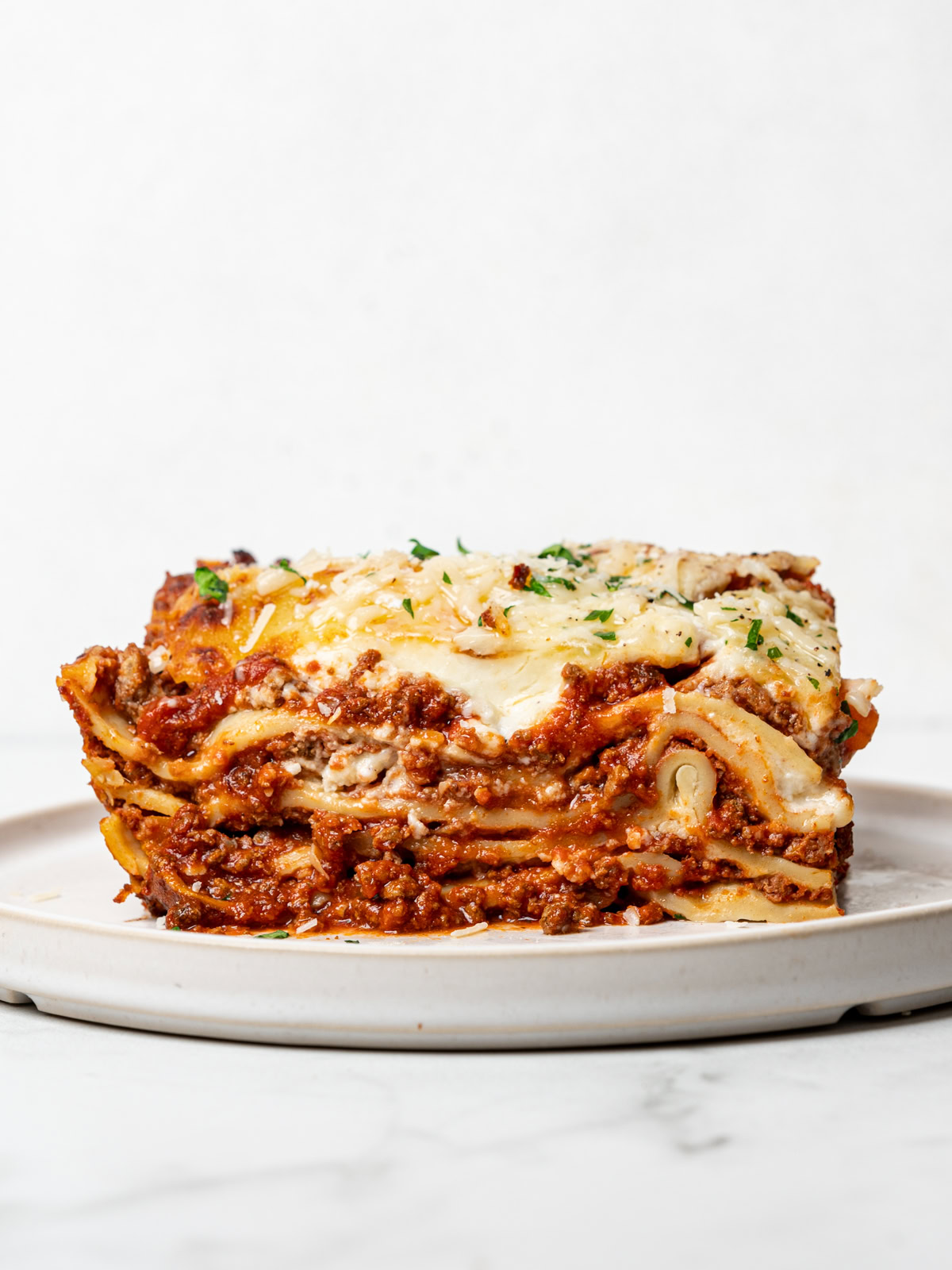
I think we can all agree, lasagna is one of the most loved pasta dishes in the world. In the colder months, especially, a bubbling majestic casserole filled with pasta, cheese, and meat sauce satisfies and comforts in ways that very few dishes can.
Which is why I believe everyone needs a great lasagna recipe in their life. A tested and true classic that will earn you praises and accolades every time you make it. Look no further, this lasagna al forno, is it.
Not going to lie, like most lasagnas, this one too is a labor of love. But the process is simple and you can make a lot of it in advance. You can even assemble the entire lasagna ahead and bake it a few days later. One bite in, and you will know that every bit of effort you put into it was 100% worth it.
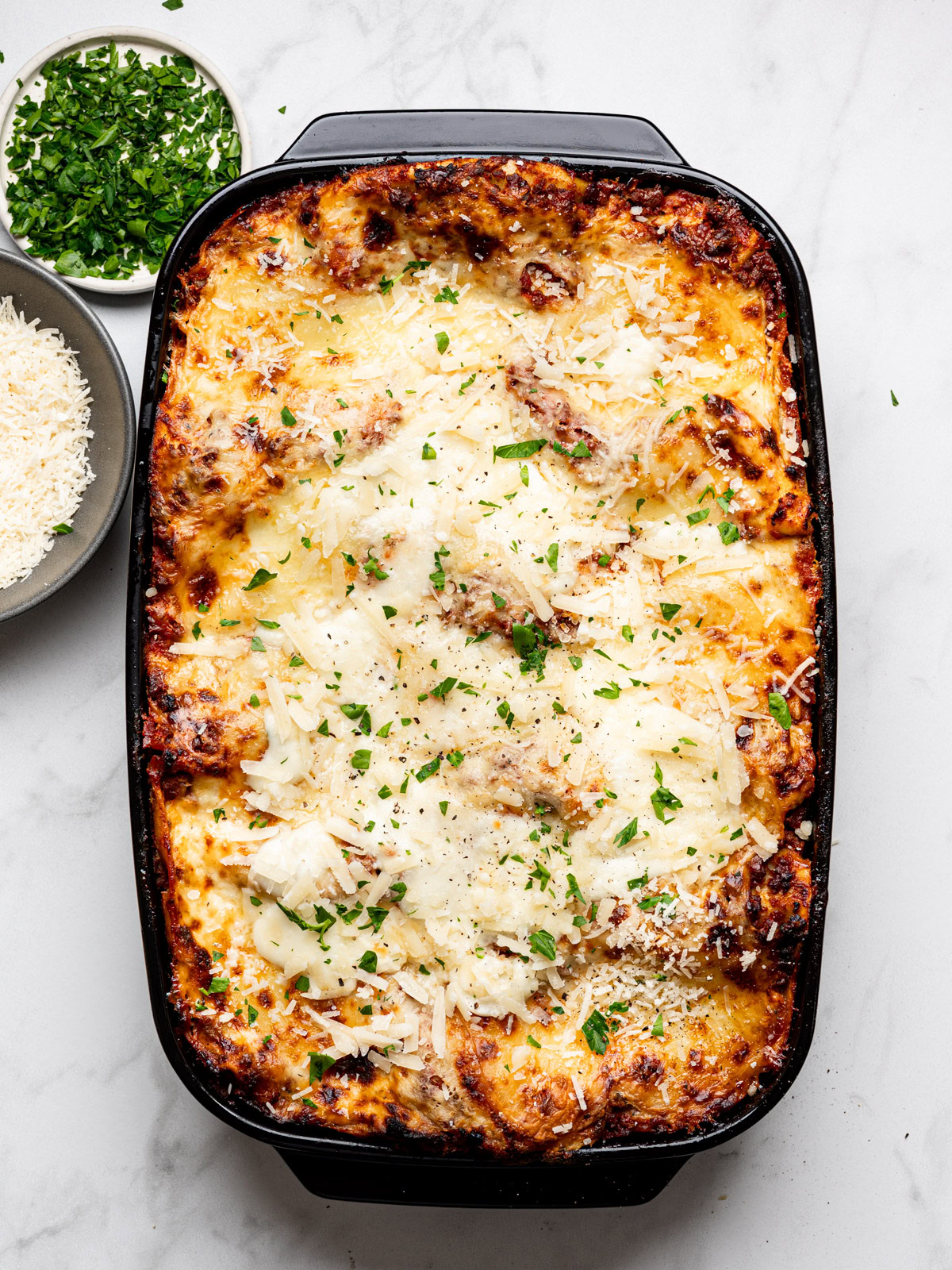
What Is Lasagna Al Forno?
The classic of all classics, lasagna al forno, hails from Northern Italy, specifically, the Bologna region. Forno, translates to oven in English. Lasagna al forno, means a lasagna that is baked in the oven. Known as lasagna bolognese in North America, it is made with many layers of fresh pasta sheets, a very creamy bechamel sauce, and a very rich ragu (meat sauce).
Notably absent from a lasagna al forno is cheese. That’s right, aside from a conservative amount of Parmiggiano, there is typically no ricotta or mozzarella in this very classic Italian lasagna. But don’t let that fool you. This gorgeous lasagna is loved globally for good reason. Oozing with rich flavors, it’s comforting, soul-satisfying, and will be your MVP this holiday season, or anytime you need a grand dish to feed a crowd through-out the year.
My Italian mother-in-law made it for Christmas every year and I too have adopted this tradition. I cannot even begin to tell you how much joy it brings everyone whenever I make it. You’re going to love it, too.
What Makes A Great Lasagna Al Forno?
There are three main components that make up a great lasagna al forno. The meat sauce, the white sauce, and sheets of pasta. Let’s dive in a little into each one.
THE BOLOGNESE SAUCE
A proper bolognese sauce is essential for a lasagna al forno. It sounds complicated, but you’re just sautéing some finely chopped veggies with ground meat, adding your liquids, then letting it all cook, mostly unattended for a few hours. Most recipes will tell you it needs to cook for 2 to 3 hours and for this lasagna, I play by the rules.
I already have a bolognese recipe on my site that we adore. Here we are using that exact recipe but I add a little more liquid to account for the longer cooking time. If you wish, you can make the bolognese sauce up to 3 days ahead.
THE BÉCHAMEL SAUCE
A classic lasagna al forno does not include ricotta or mozzarella cheese. It’s only pasta, meat sauce, bechamel, Parmesan, done. Again, we are not breaking any rules here so the creamy, cheesy component of this lasagna relies solely on the creamy béchamel sauce which comes together in about 10 minutes.
The béchamel, also known as besciamella in Italy, is made with butter, flour, milk and seasoned with nutmeg. We also add some parmesan cheese for more flavor.
THE PASTA SHEETS
Here we are cheating. Homemade pasta sheets would absolutely be lovely in this lasagna. It’s just not a project most people, including myself, are willing to tackle on top of making everything else for the lasagna.
Store-bought fresh lasagna sheets are ideal but they aren’t always easy to find. I used fresh ones from an Italian deli but they were way thicker than I’d like so I won’t be using them again. If going the dry sheets route, I recommend using no-boil because they will save you a lot of time. I have had pretty good success with Delverde or De Cecco no-boil sheets.
Ingredient Notes
These are the ingredients needed to make this classic lasagna recipe:
Bolognese Ingredients
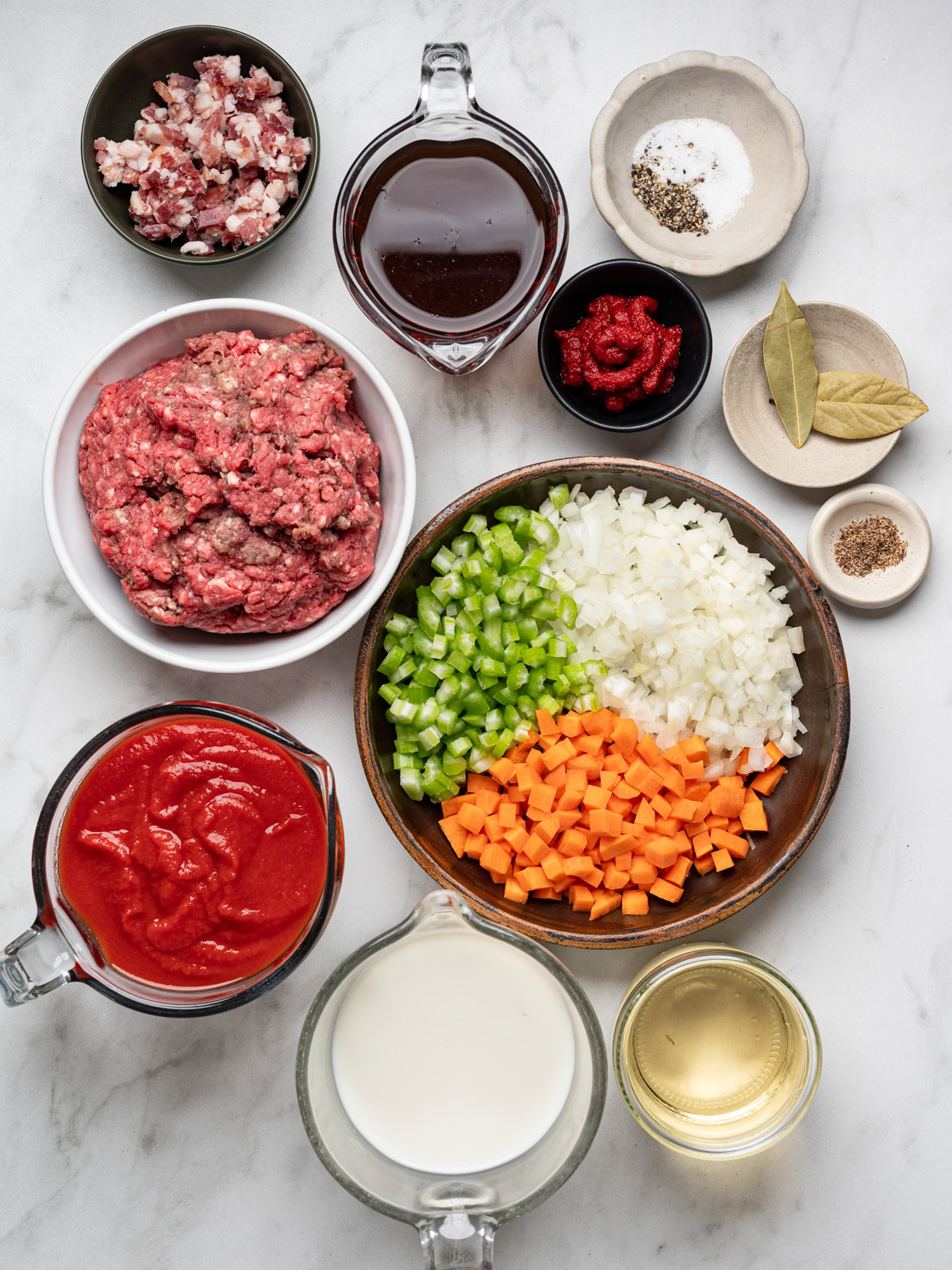
Béchamel Ingredinets
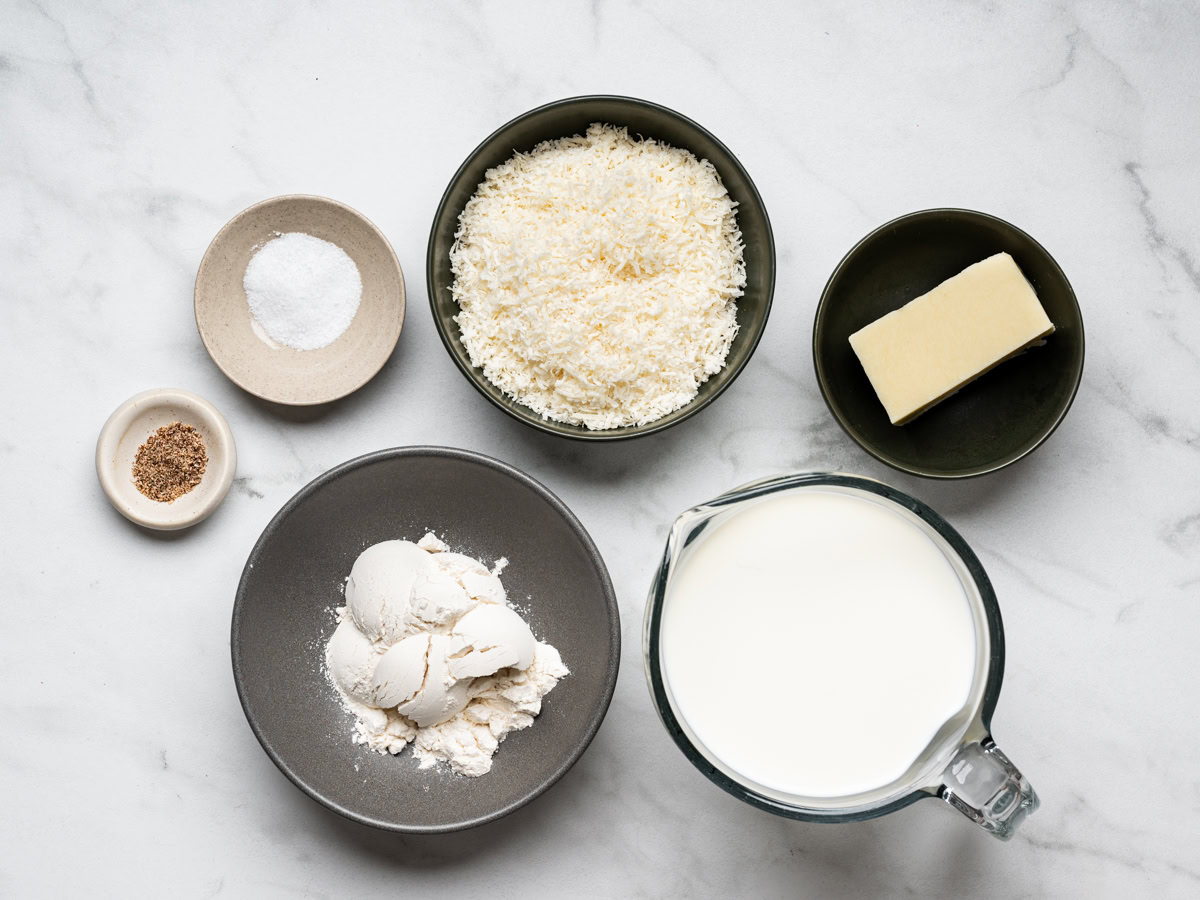
Lasagna Ingredients
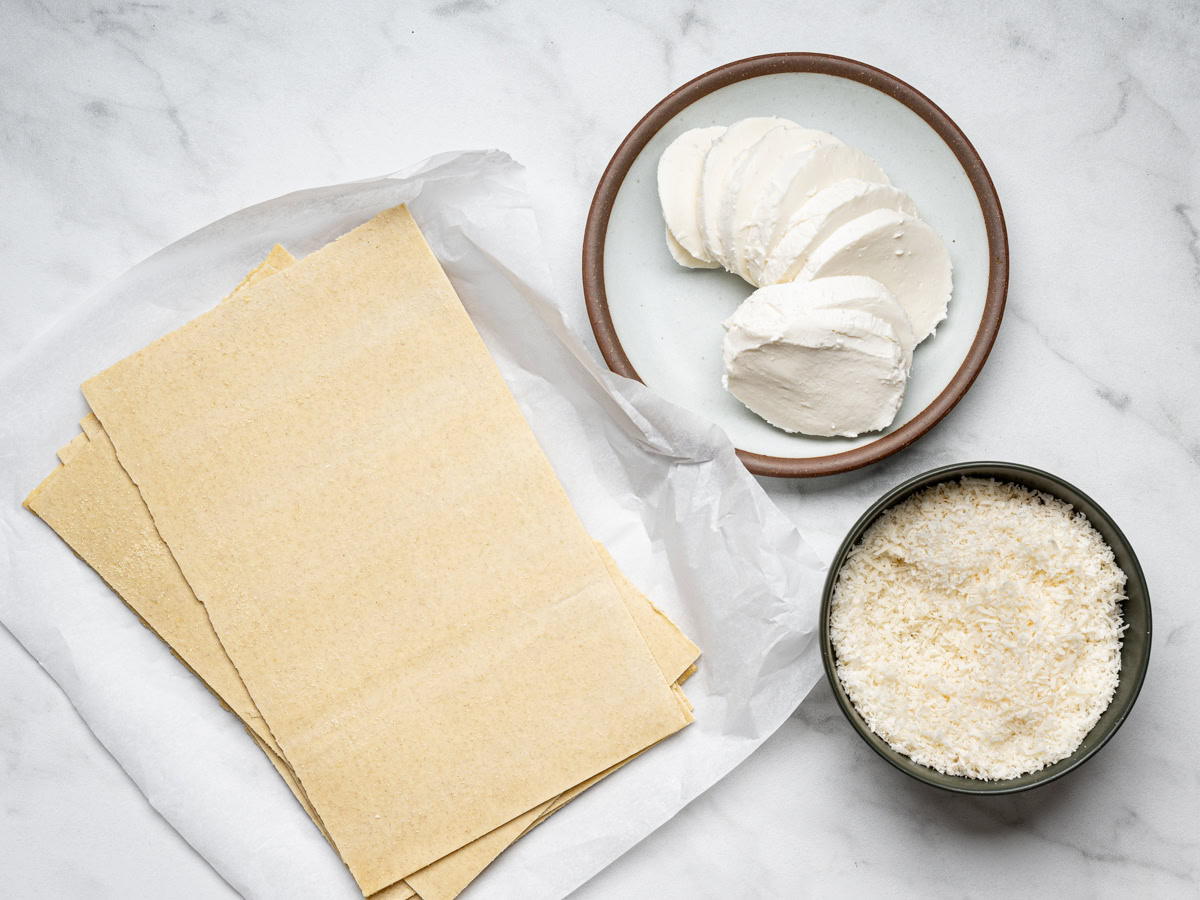
- Ground beef: I use only lean ground beef to make my Bolognese. If you prefer, you can use a mix of beef and pork or sausage.
- Pancetta: Similar to bacon, pancetta is Italian cured pork belly, but it is typically not smoked. It will add great flavor to the bolognese sauce but if you prefer to leave it out, the sauce will still be delicious.
- Onions, carrots and celery: Also known as the sofritto, these three ingredients are non-negotiable in a Bolognese. You want the veggies to be very finely chopped so they melt into the meat. Here I chopped them by hand but a food processor will of course chop them even finer and save you a little time.
- Tomato sauce: Bolognese is not heavy on the tomatoes. In fact, some traditional recipes omit it altogether relying solely on tomato paste. I prefer my bolognese sauce with the addition of 1 jar of passata or 1 can of tomatoes (pureed or crushed).
- Tomato paste: The concentrated paste adds nuance and body to the sauce. To intensify the flavour of the paste, I like to brown it a little in the pan before adding the liquids. This sort of caramelizes and sweetens the paste which adds more flavour to the sauce.
- Beef stock: Most traditional recipes will not include beef stock in a bolognese. But I feel like the ragú benefits from the extra liquid to keep it from drying out, so I always include it. Make sure you always use low-sodium, or no sodium broths if they aren’t homemade.
- Wine: Dry white wine is traditionally used in a bolognese sauce. Go ahead and use red if that is what you have.
- Milk: In Bologna, dairy is used to round out the acidity of the tomatoes in the Bolognese sauce. If avoiding dairy, you can leave it out but the sauce will not be as silky.
- Nutmeg and bay leaves: As with milk, nutmeg is used to tone down the acidity of the tomatoes in the ragú. Bay leaves add nice complexities to stews but you can omit, if you wish.
- Béchamel: To make the béchamel sauce you will need butter, flour, milk (whole milk is best), nutmeg, parmesan, salt and pepper.
- Lasagna sheets: As I mentioned above, I like to use store-bought fresh pasta if I can find it. If the fresh pasta sheets are too thick, or you can’t find them, go with dried sheets. More on pasta sheets below.
- Parmesan: We are suing some parmesan in the béchamel sauce, but I also like to sprinkle some in between the layers and over the top of the lasagna. It probably goes without saying, but please refrain from using the green bottle stuff which will ruin your beautiful lasagna.
- Fresh Mozzarella: Ok, I know, I said no cheese in a classic lasagna al forno. But for those of you who simply can’t resist adding some mozzarella, you can do as I did and top the lasagna with some slices of fresh mozzarella. But this is entirely optional and I only add it when my cheese-loving youngest is visiting. Promise, the lasagna will be just as luxurious and delicious without it.
How To Make Lasagna Al Forno: Step-By-Step
To be sure, lasagna al forno is a bit of a project but the process truly couldn’t be simpler. Once your sauces are done and pasta sheets are sorted, assembling the lasagna is a breeze.
I like to use a two-bake process for baking the lasagna. First, the lasagna bakes covered with foil so the trapped moisture warms and bakes the lasagna through. Half way through, the foil is removed so the lasagna has a chance to set beautifully and get all golden brown and crispy-edged.
Here is an overview of the 3 main steps. The detailed measurements and instructions can be found in the recipe card below.
Make The Bolognese
Sauté the pancetta until it releases most of its fat. Add the chopped vegetables and cook until very soft.
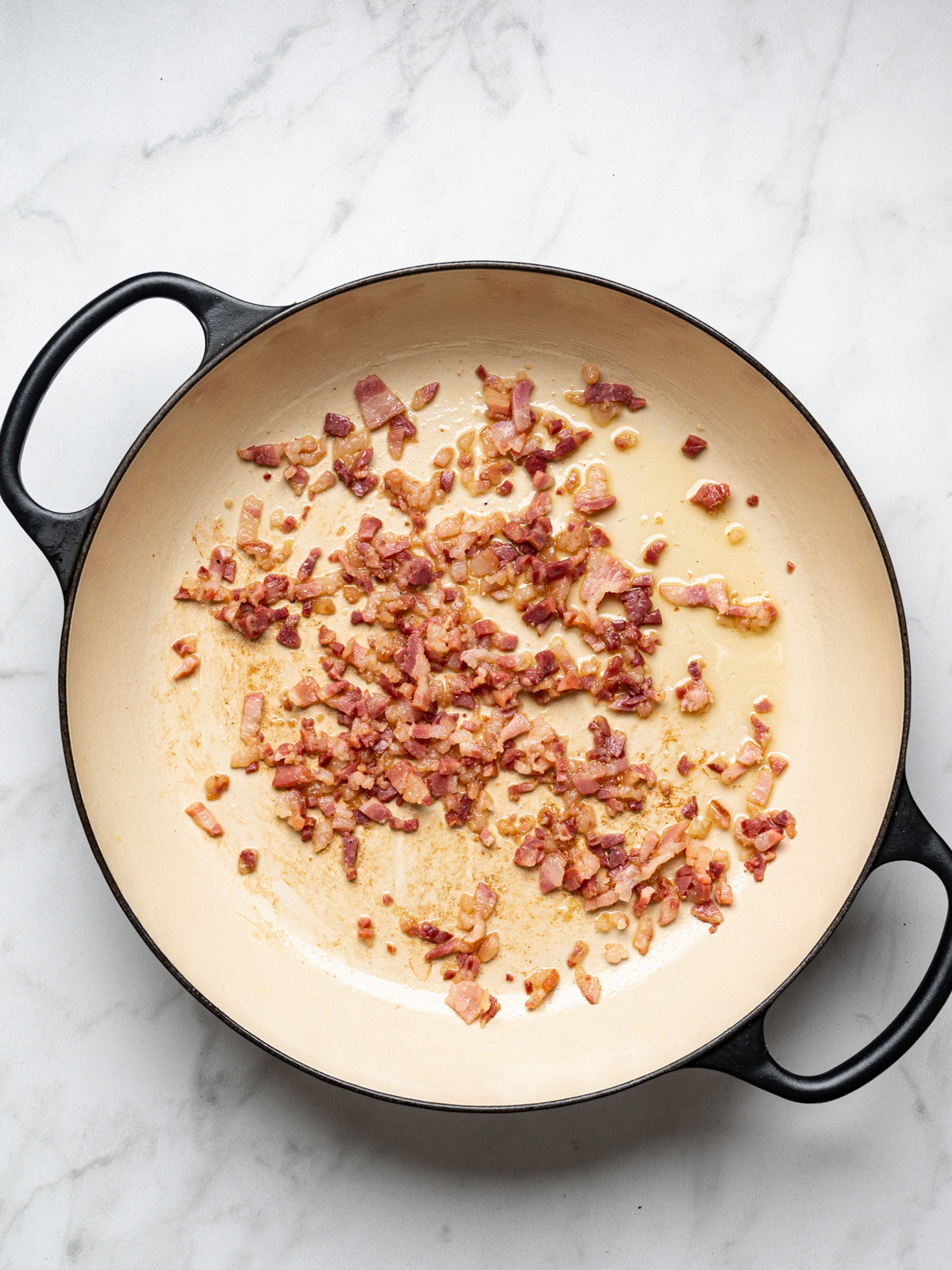
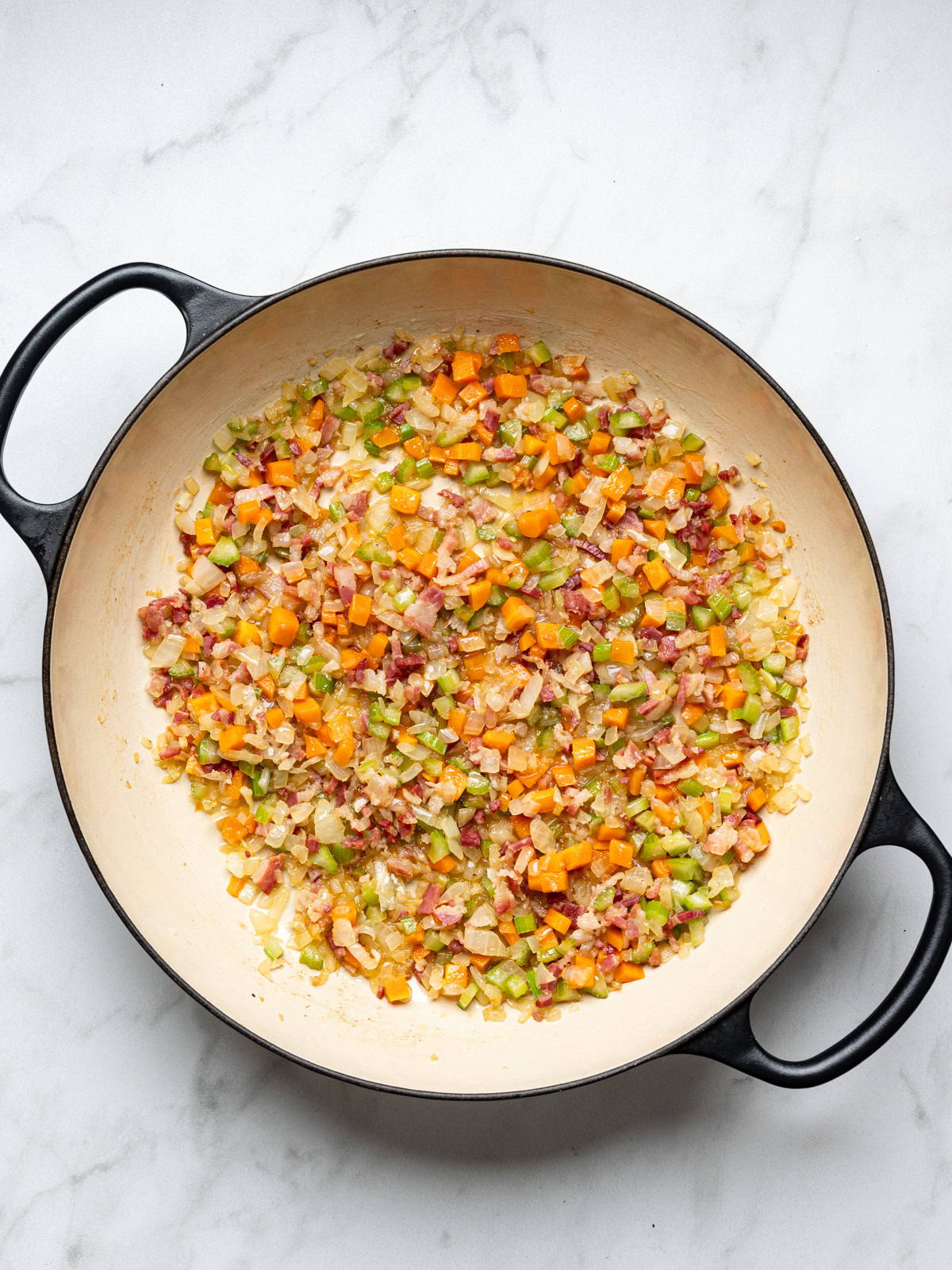
Add the meat and cook until brown, breaking it up with a wooden spoon. Stir in the tomato paste then pour in the milk. Cook until the meat has absorbed most of the milk, about 4 to 5 minutes. Add the wine and let it simmer until slightly reduced.
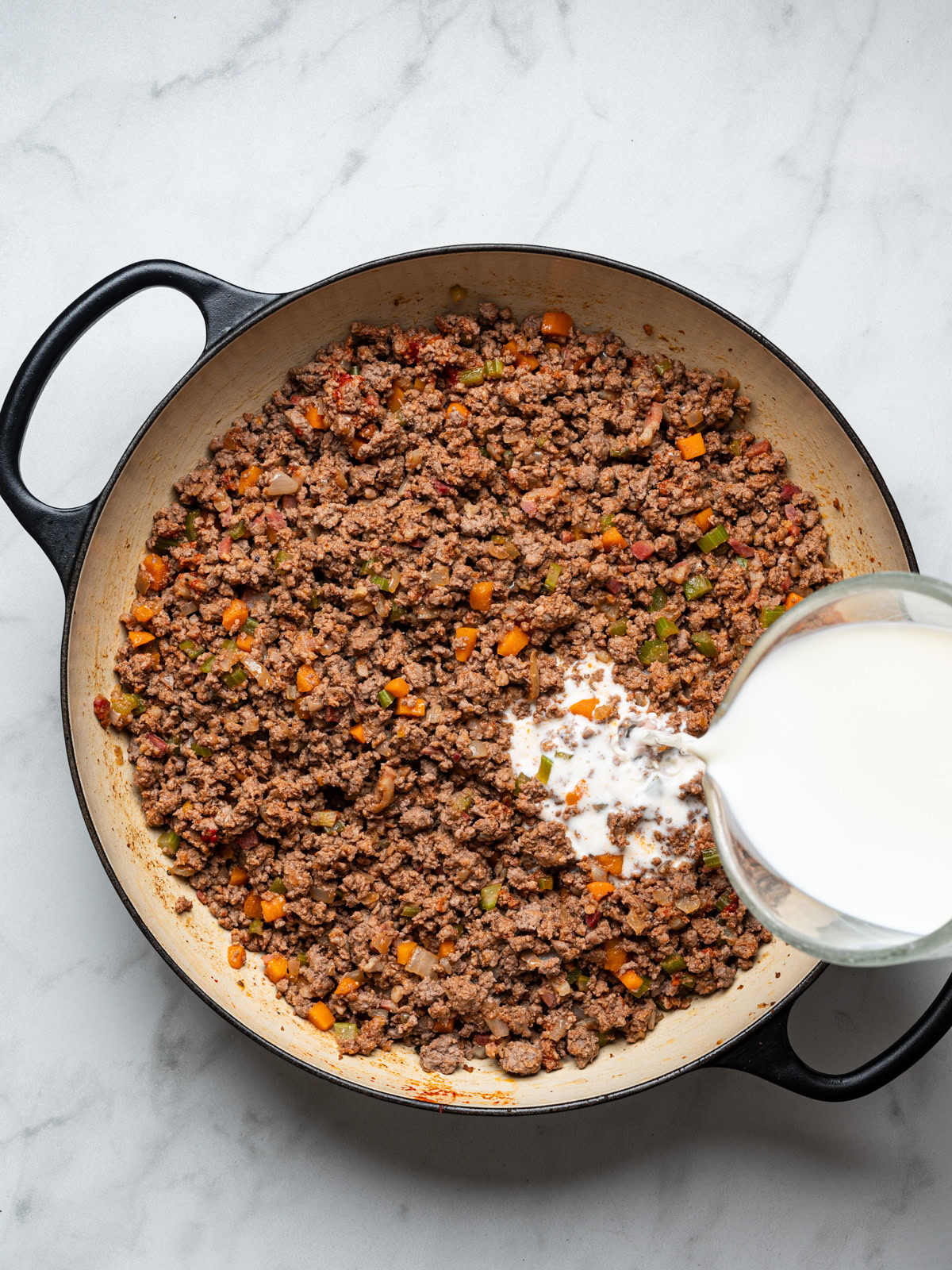
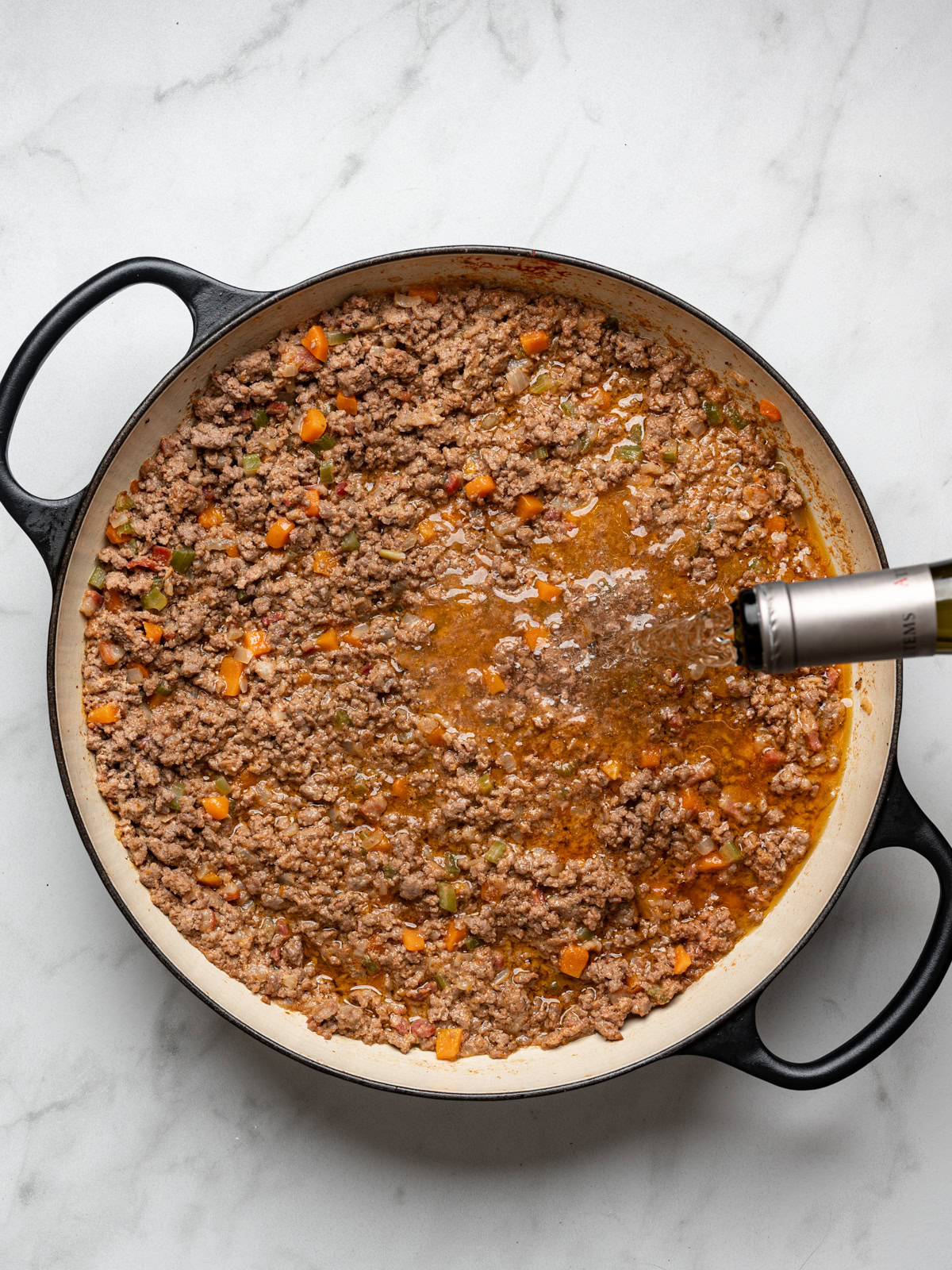
Next, add the passata, bay leaves, nutmeg and 2 cups of beef broth. Let simmer, uncovered, until the bolognese looks rich, thick, and tastes delicious, about 2 to 3 hours. If not using immediately, let cool and refrigerate, covered, for up to 2 days.
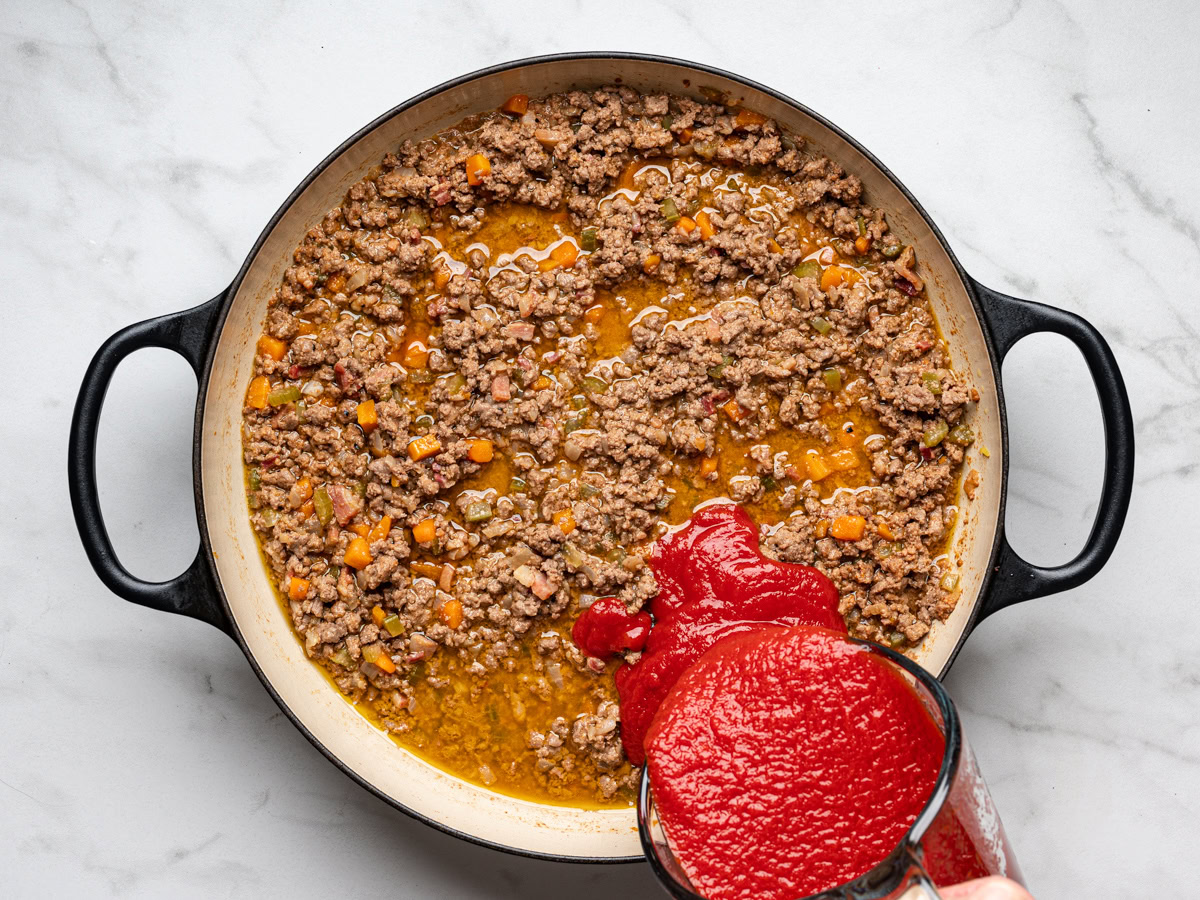
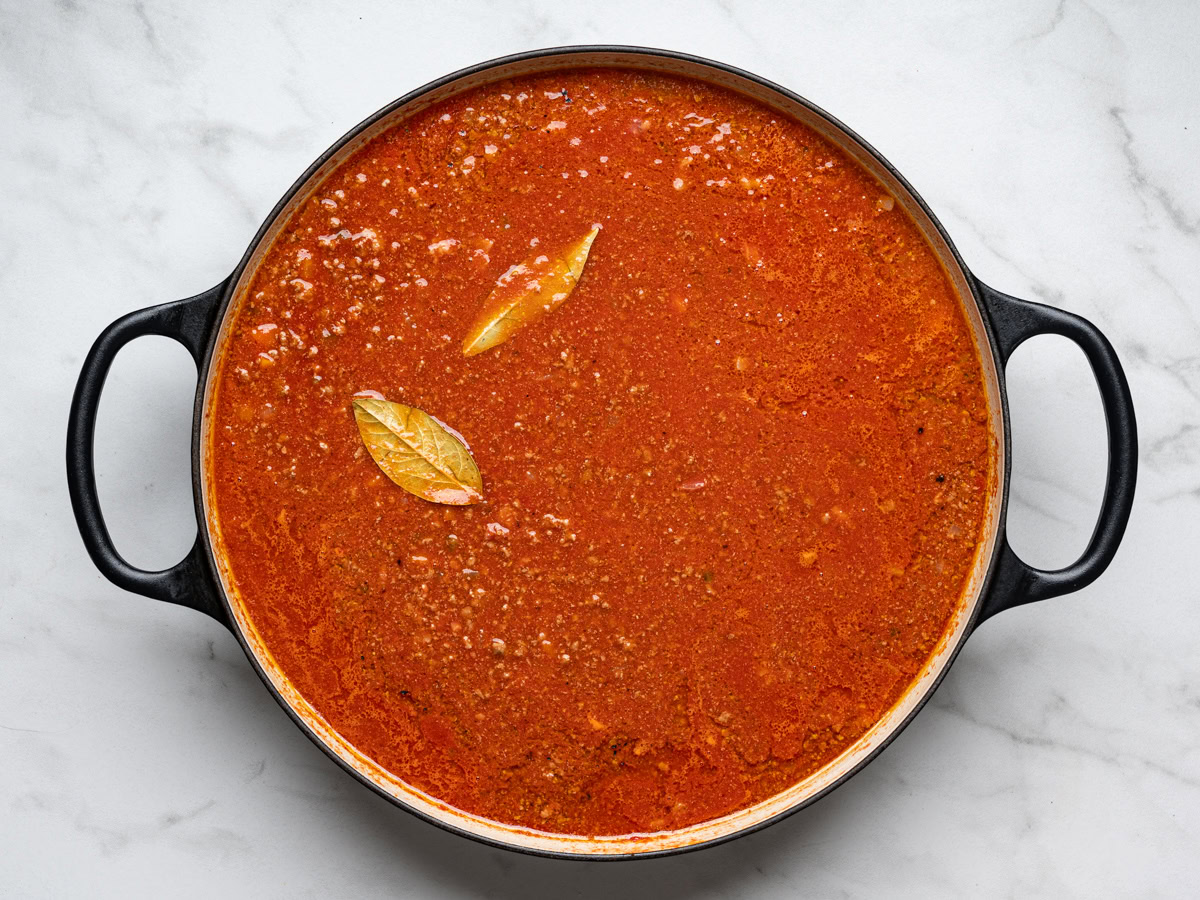
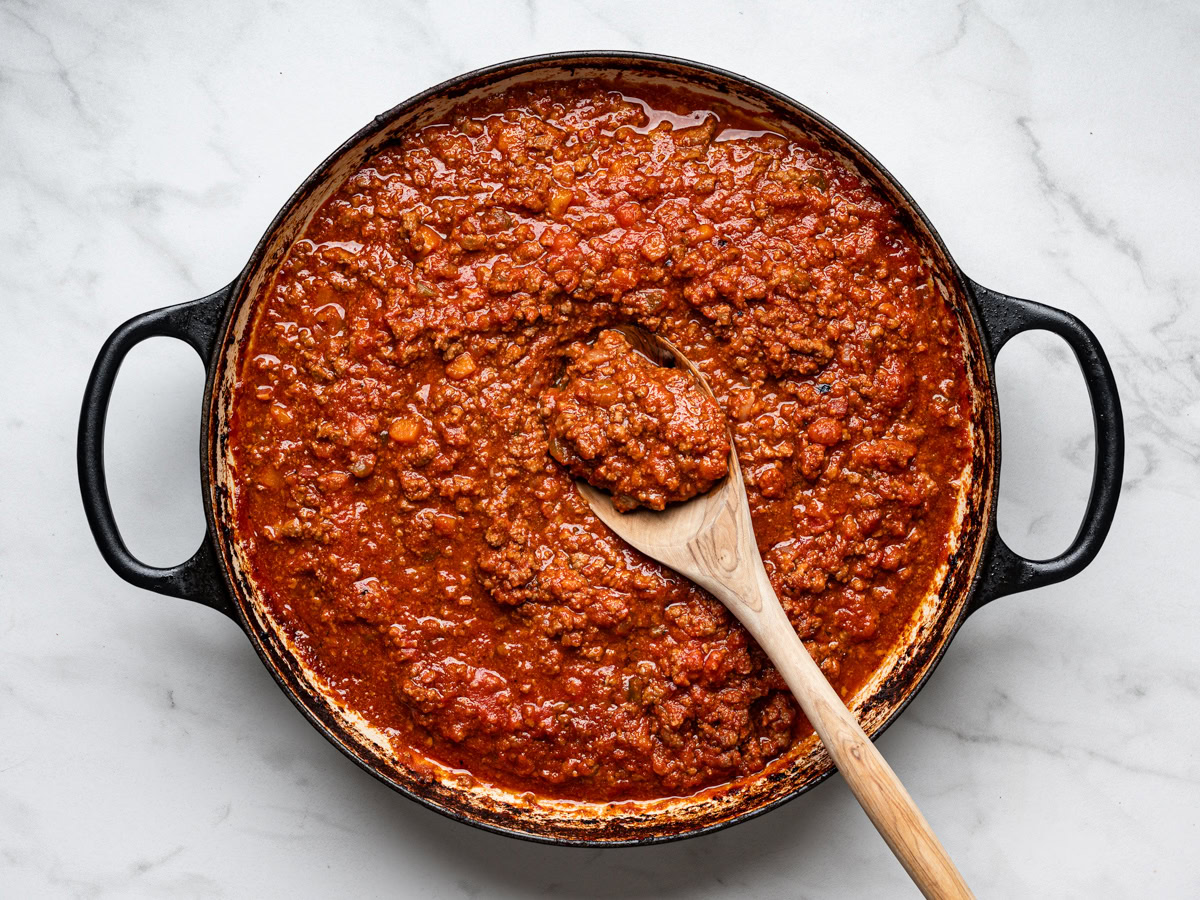
Make The Béchamel
Add butter to a medium saucepan set over medium heat. Cook until melted and bubbling, then sprinkle in the flour.
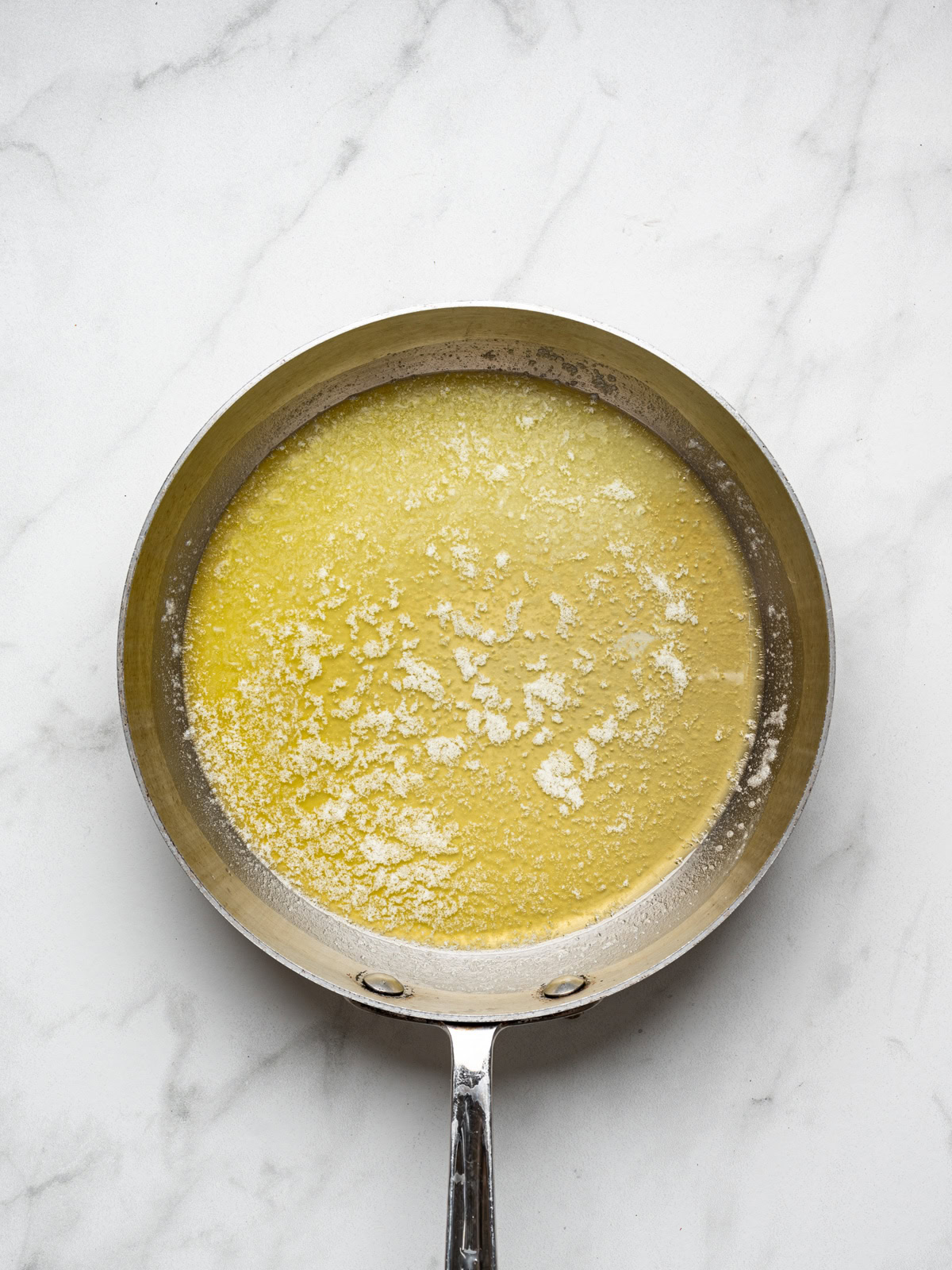
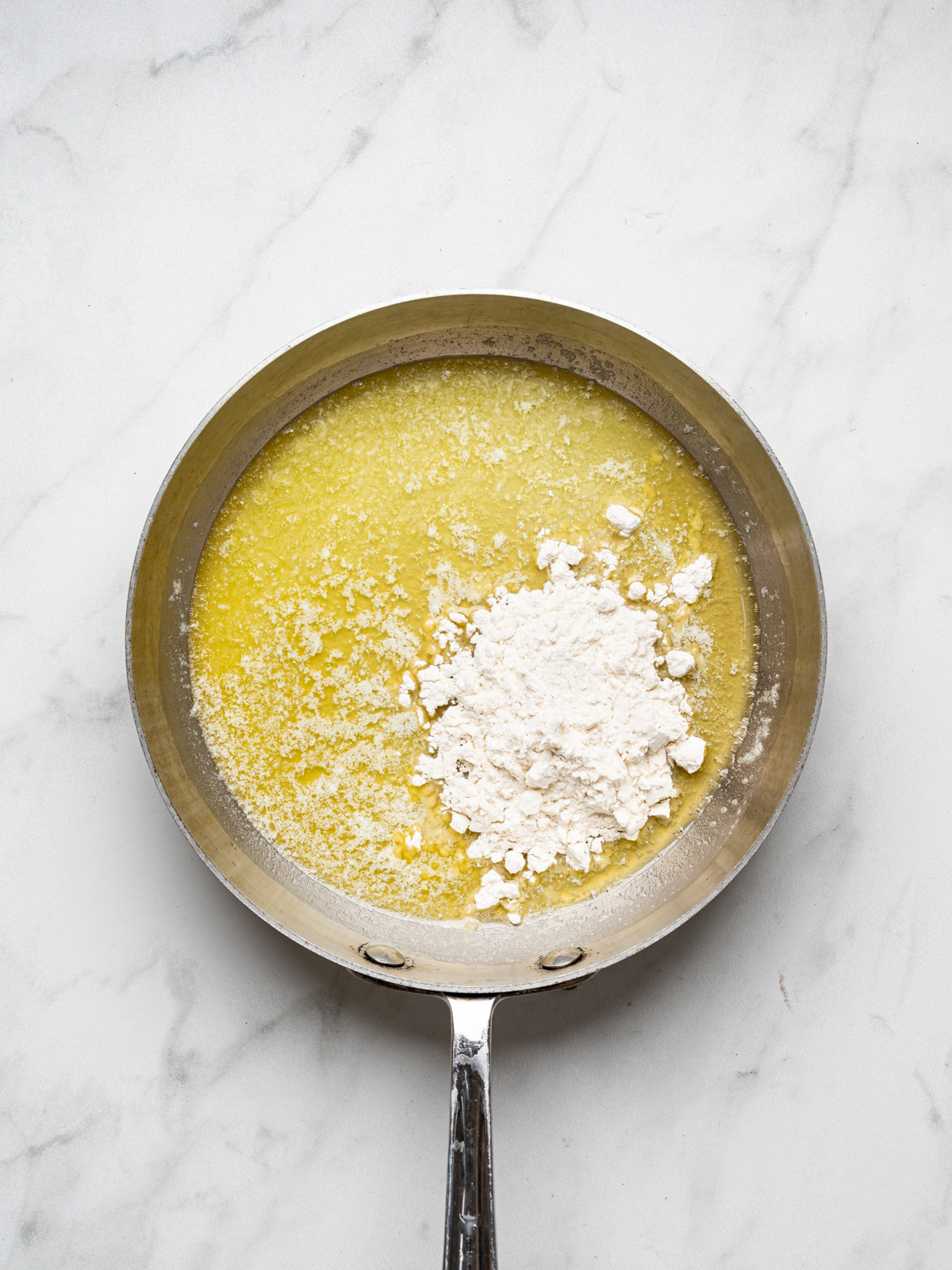
Whisk the butter and flour until a smooth paste forms. Continue whisking, and let paste cook about 1 to 2 minutes. Slowly drizzle in the milk, whisking constantly so no lumps form.
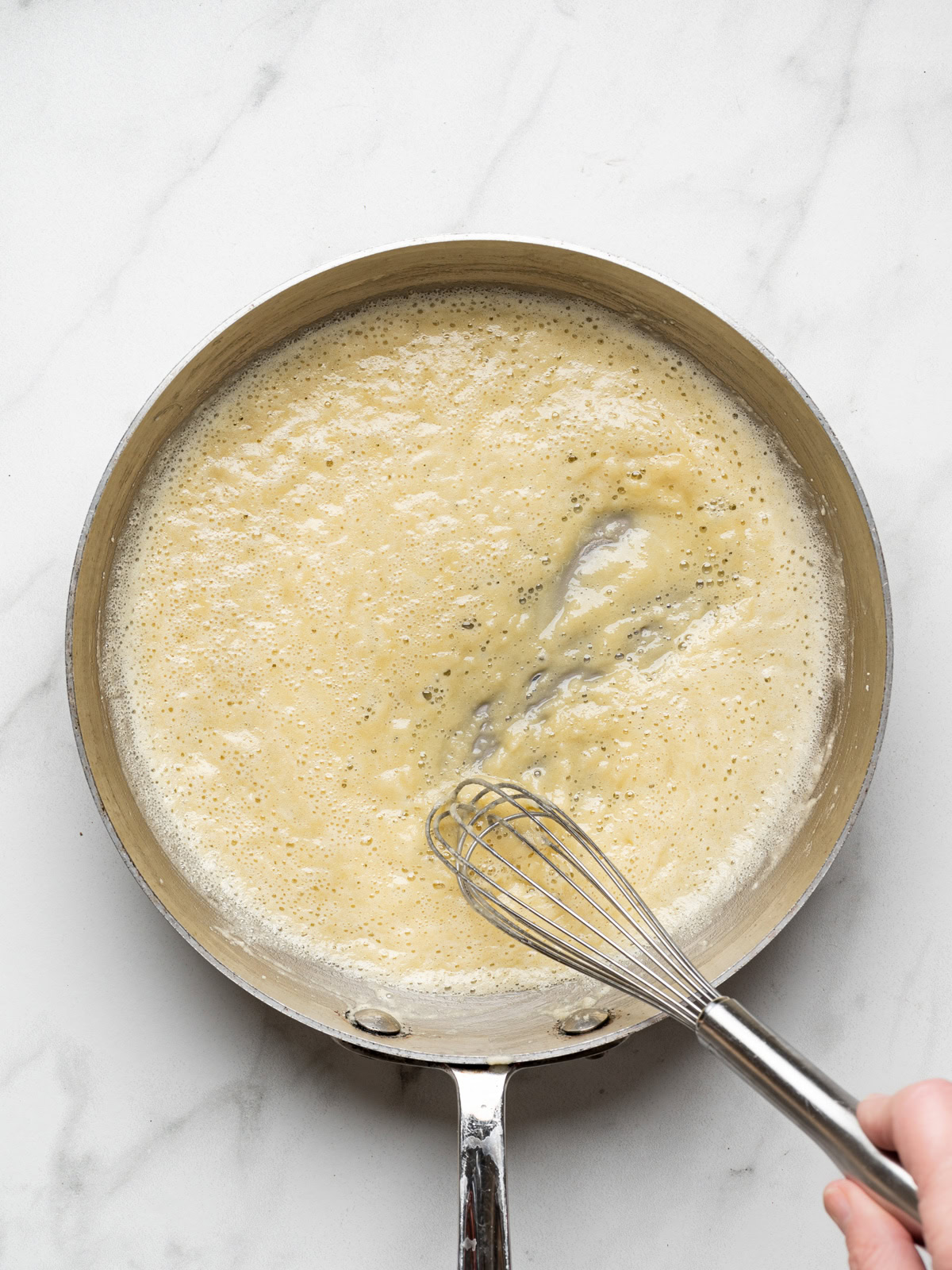
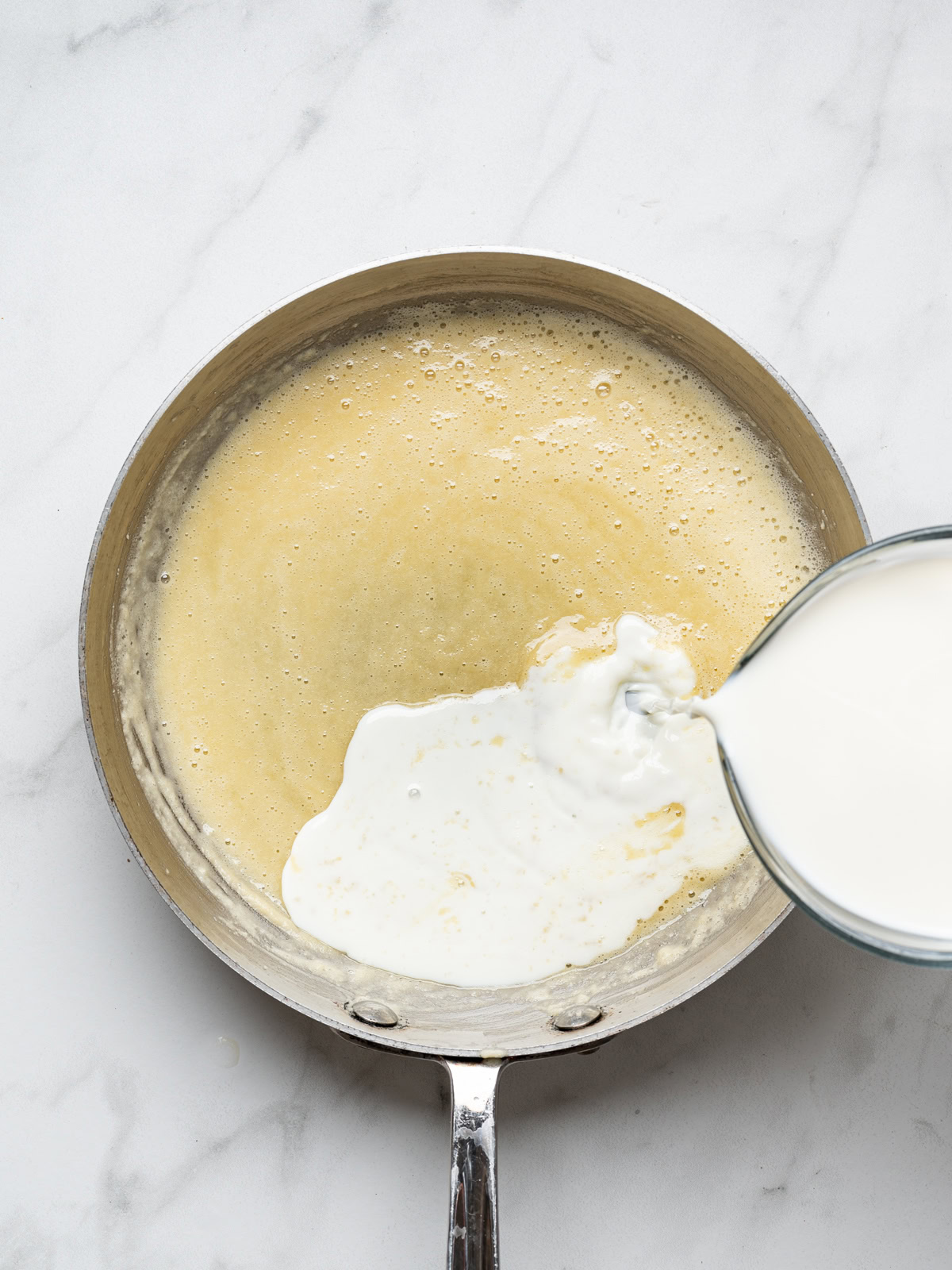
Continue to cook, over medium heat, stirring frequently, until sauce thickens and coats the back of a wooden spoon, about 8 minutes. Remove from heat and season with salt, pepper and nutmeg (if using), and stir in the parmesan.
If not using immediately, place a piece of plastic wrap directly over top of sauce to prevent a hard film from forming.
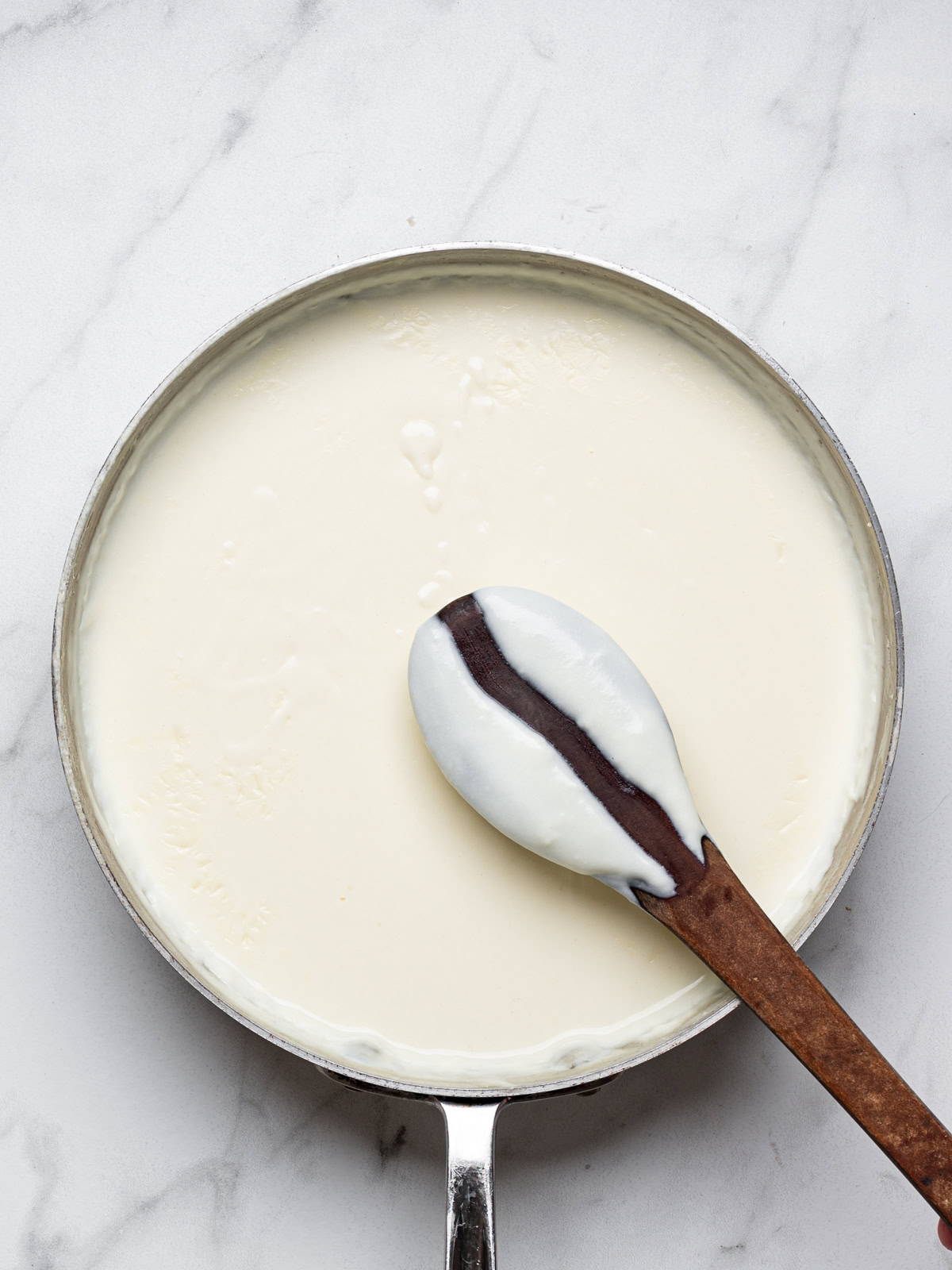
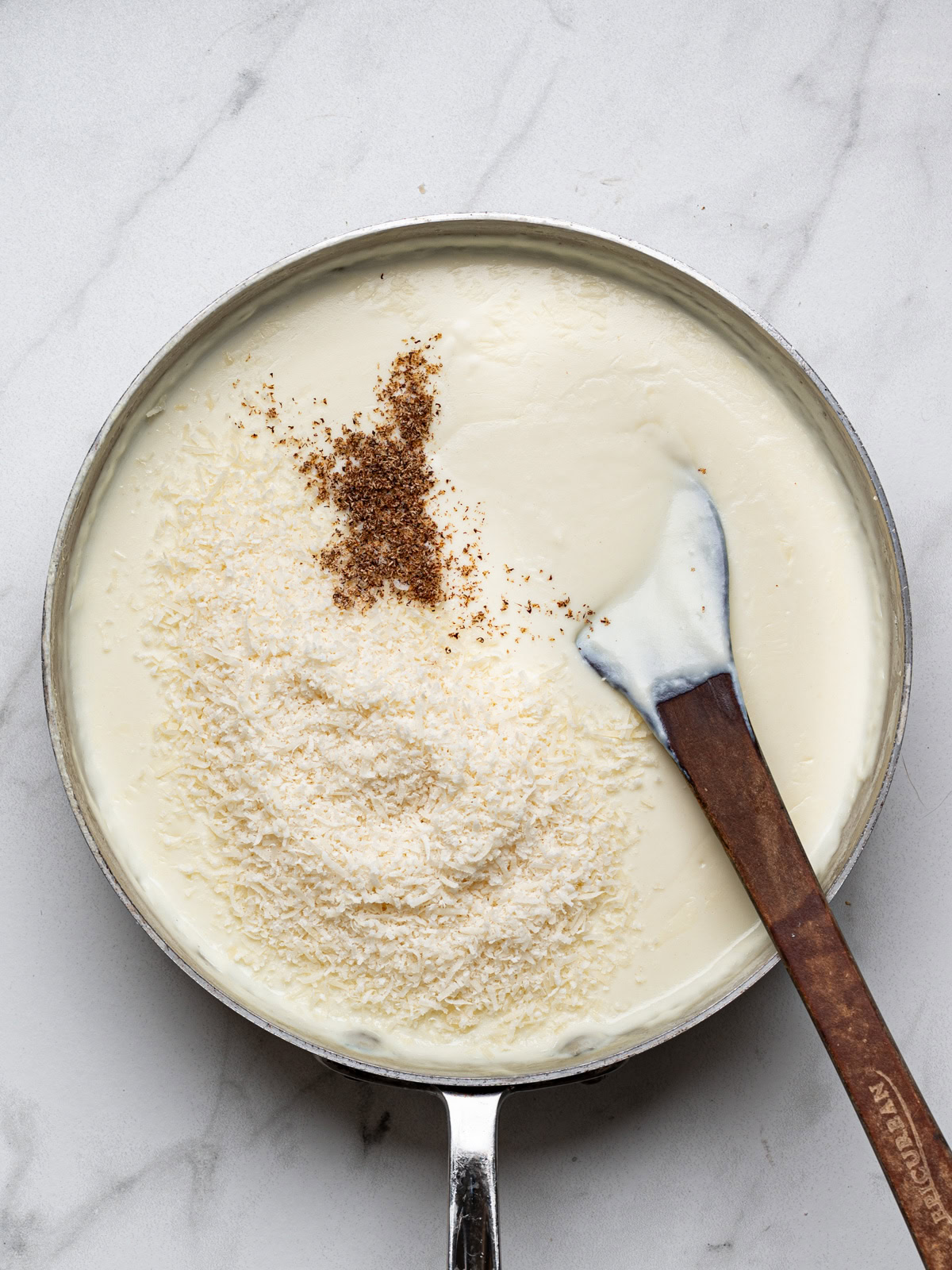
Assemble The Lasagna
A great lasagna will not fall apart when served. Rather, it will have a structurally sound base from components that have been cooked properly, as well as layered properly. Here’s what to do:
First, lightly butter a 9×13 baking dish. Spread a little bolognese sauce over the base. If your bolognese sauce seems very thick, add 1 cup of broth to loosen it. Next, add a single layer of pasta sheets on top of the sauce. It’s okay if you need to cut some of the sheets to make them fit.
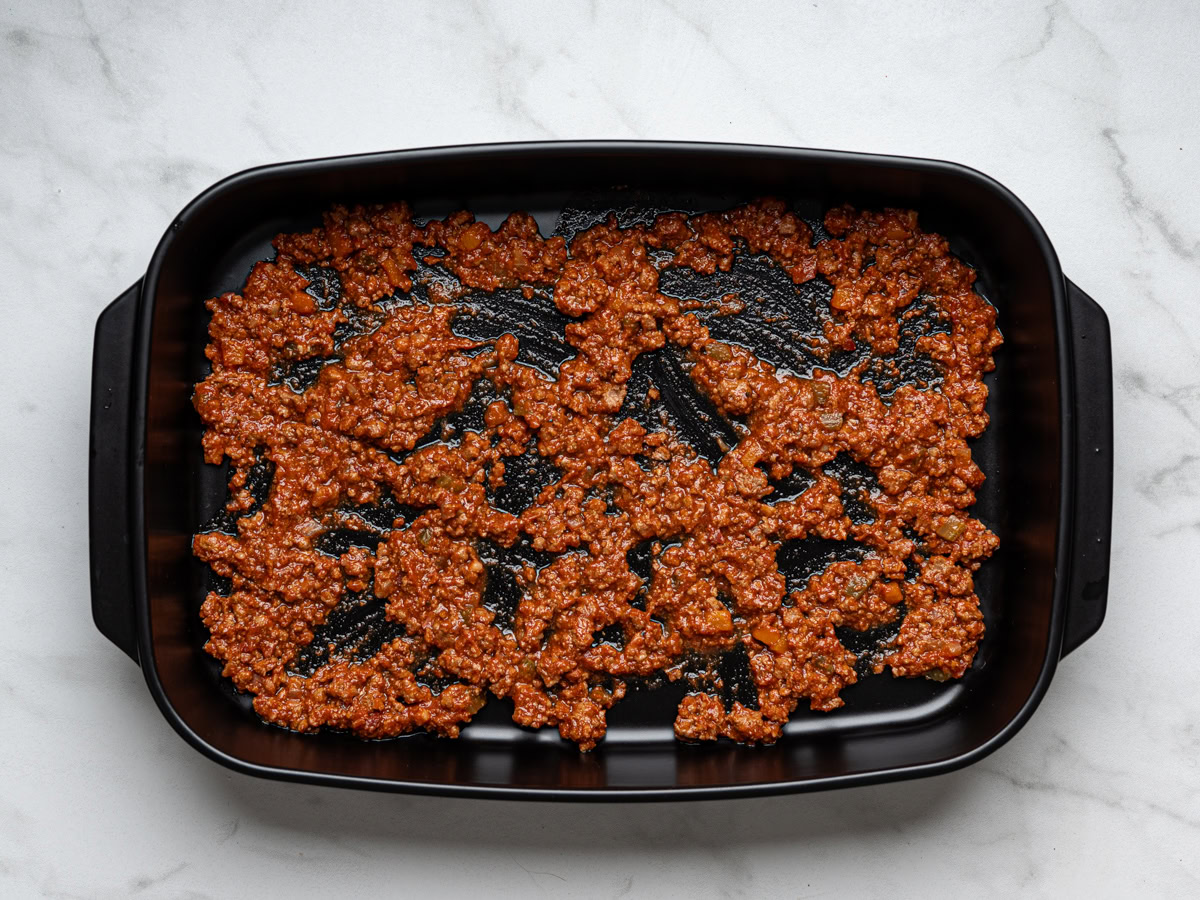
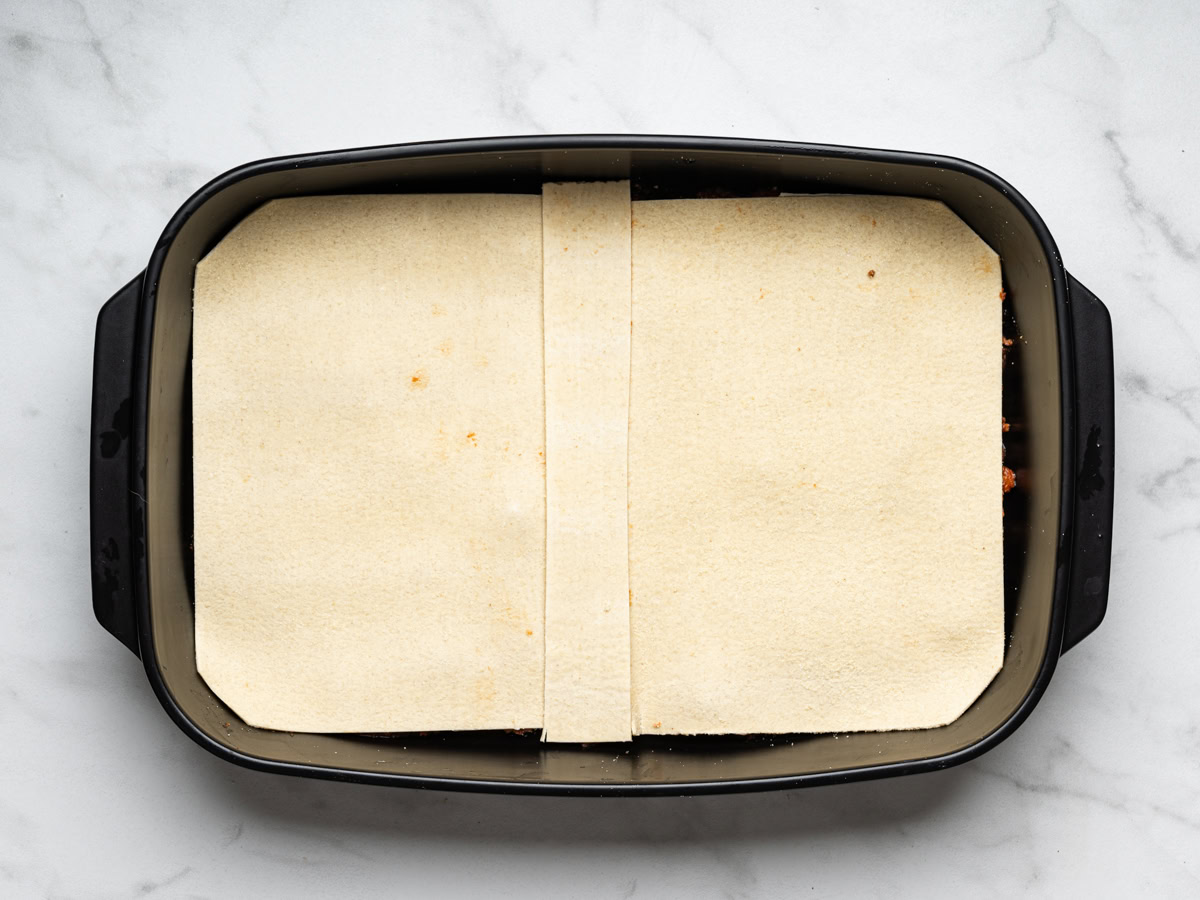
Then, add a thin layer of bolognese followed by a layer of béchamel. Repeat the process, finishing with a layer of pasta topped with béchamel sauce. You should have 4 to 5 layers. If using fresh mozzarella slices, scatter them evenly over top of your lasagna and sprinkle with parmesan cheese.
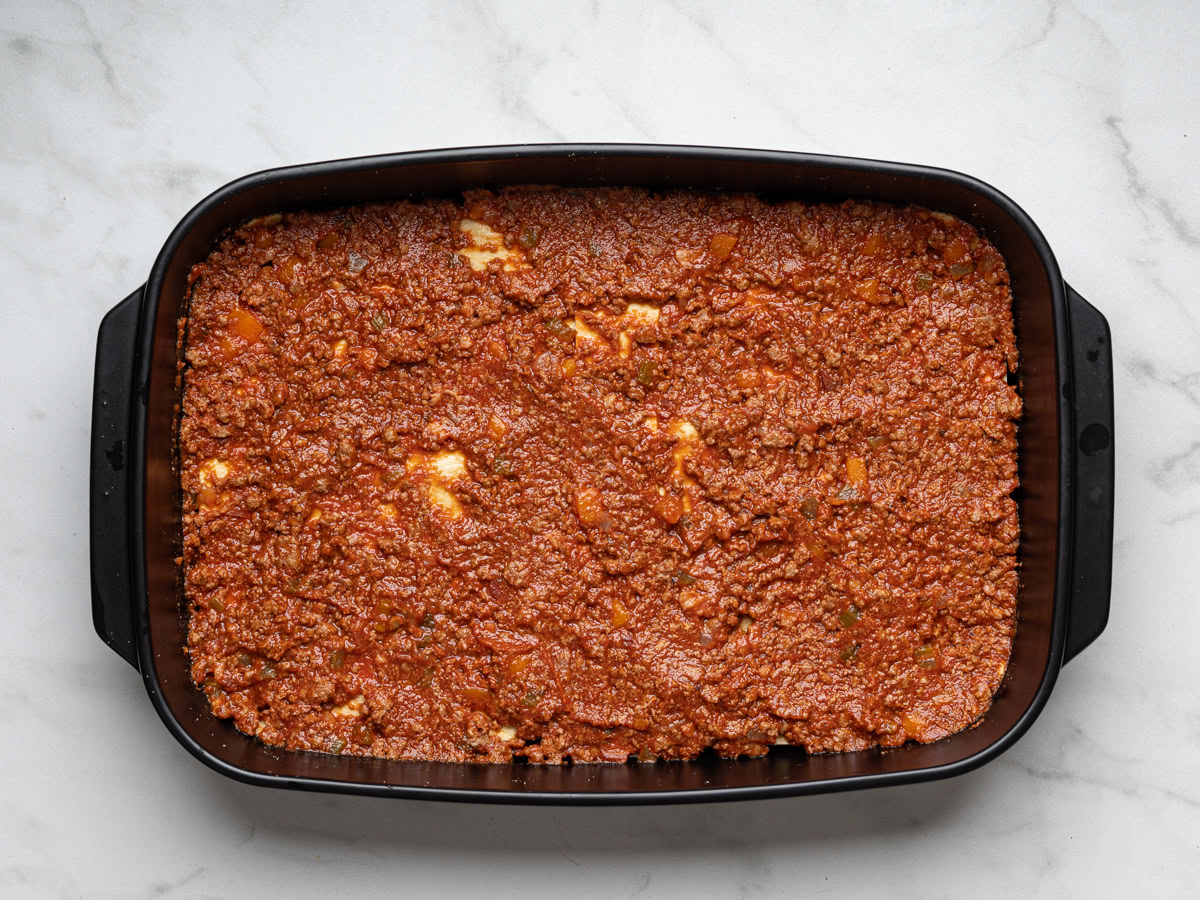
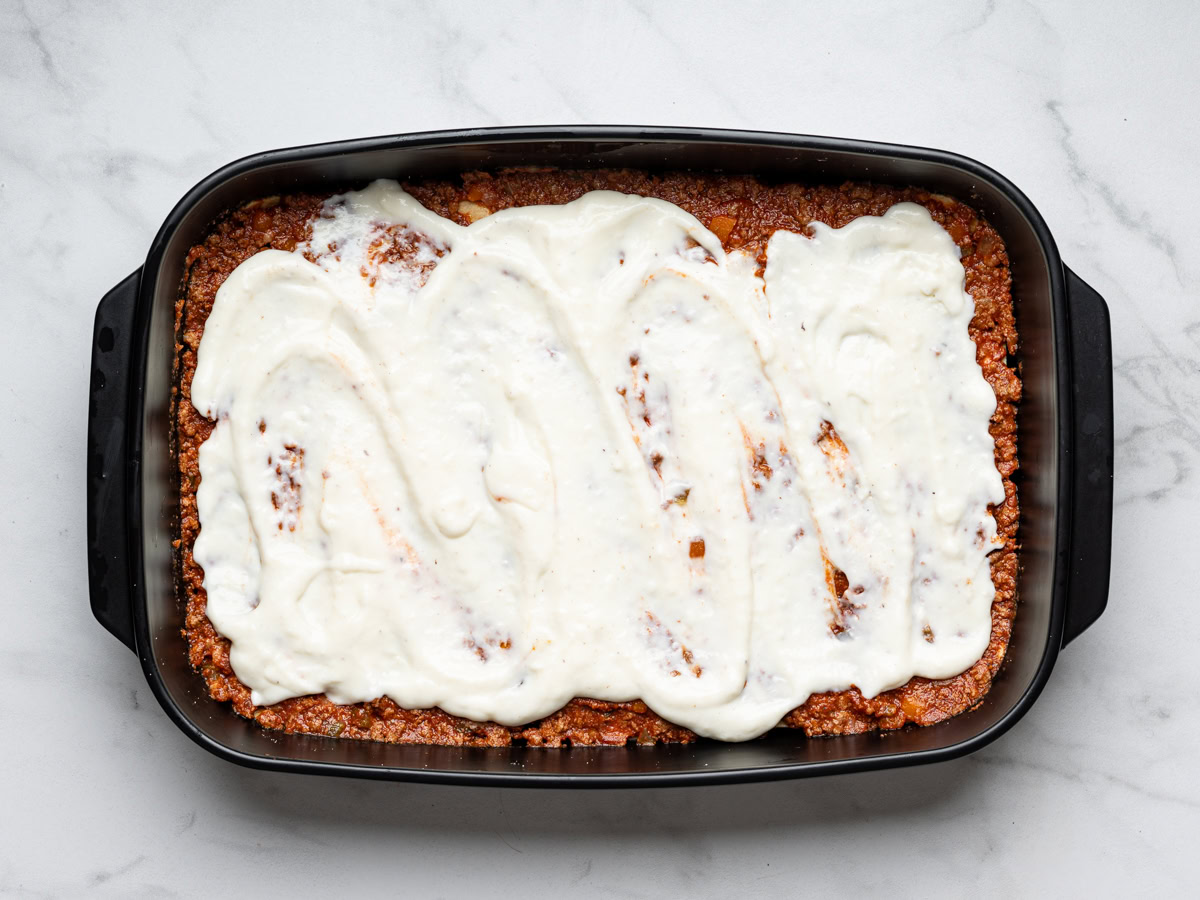
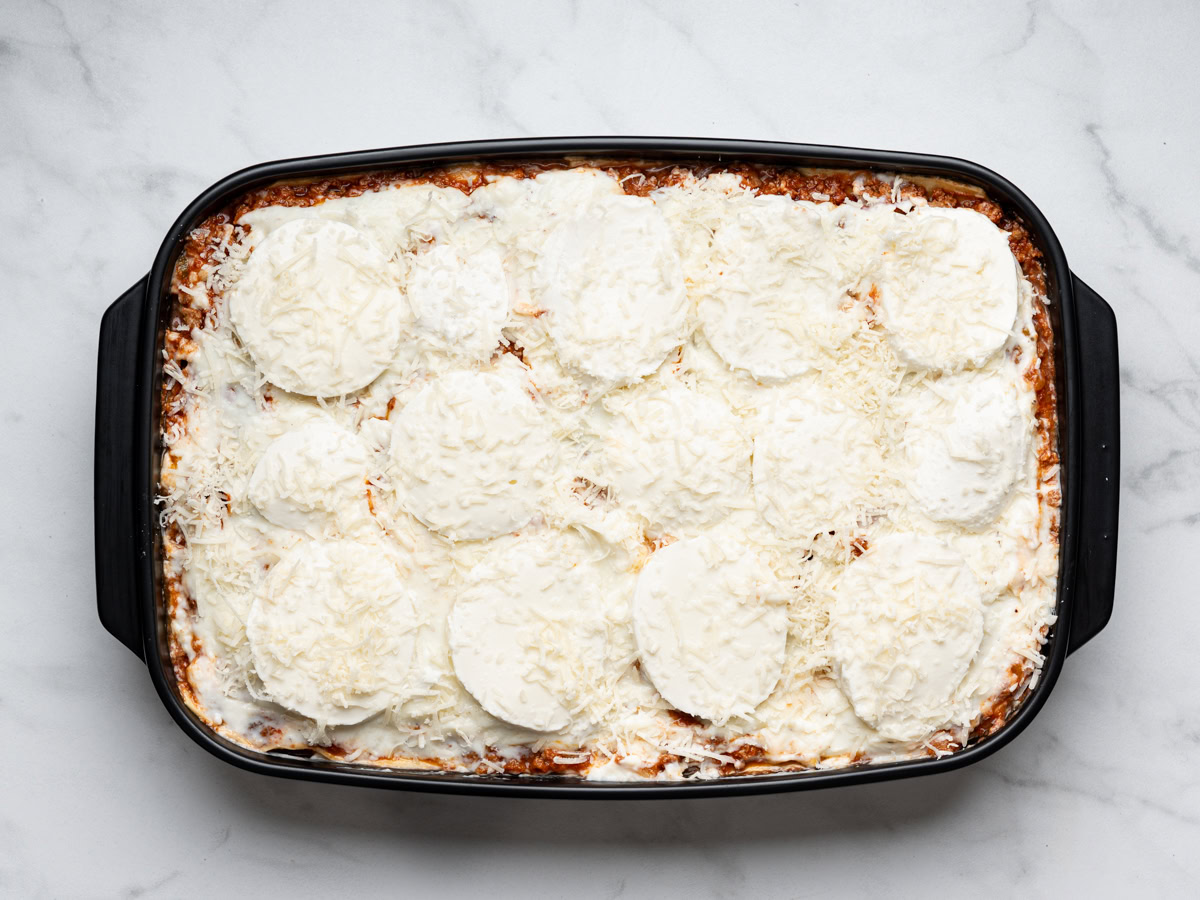
Bake The Lasagna
Cover the entire pan with foil and bake for 25 minutes. Remove foil and bake until lasagna is bubbly, golden brown, and crispy-edged.
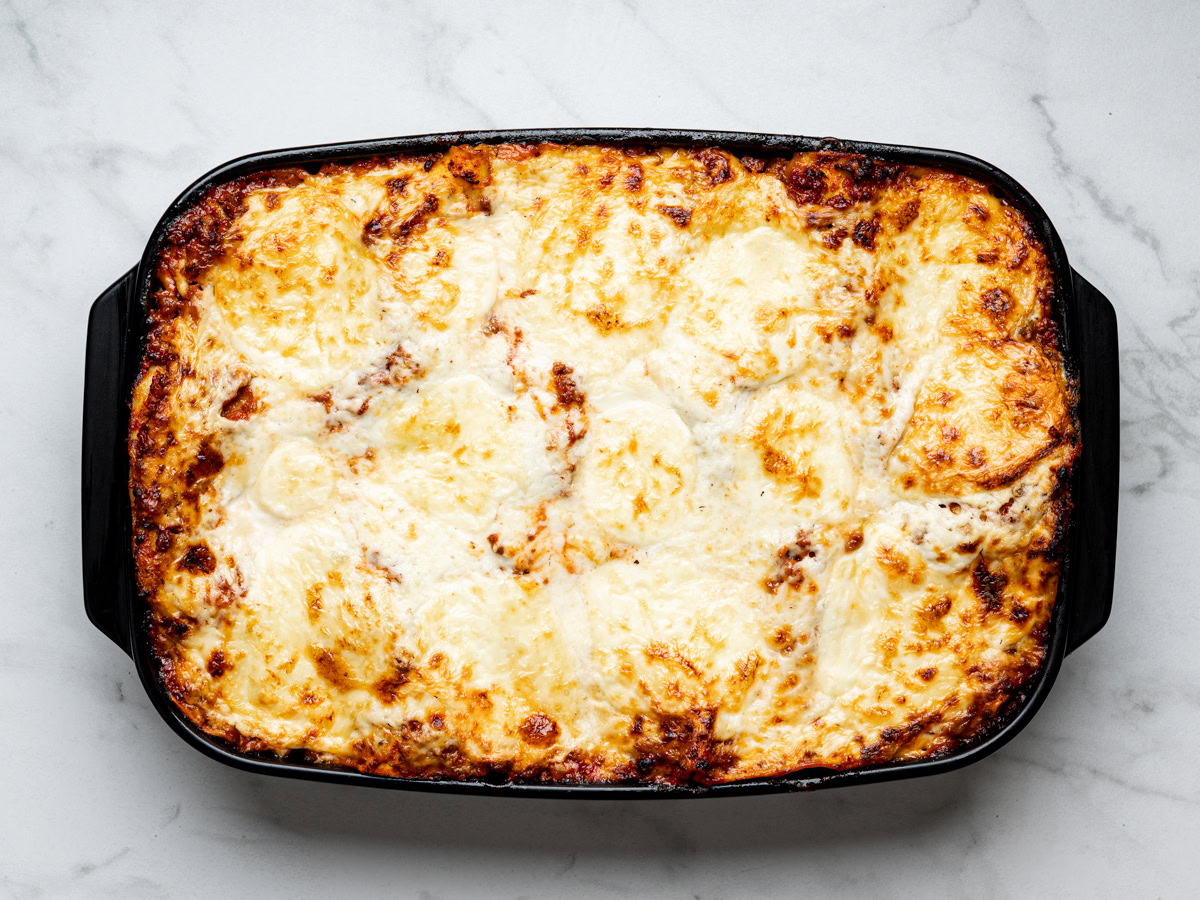
Expert Tips
- Use whole milk to make the béchamel. For best results, use whole milk to make the béchamel sauce. Low-fat milk will take a lot longer to thicken and the sauce will not turn out as creamy and oily.
- Let lasagna slightly cool before slicing. Allow the lasagna to sit for at least 15 minutes before slicing. This makes it much easier to cut and serve without the layers falling apart.
- Use fresh pasta, if possible. For best results, try and use store-bought fresh pasta. Otherwise, use a good, reliable dry pasta (boil or no-boil will work).
- If boiling pasta sheets, don’t overcook. Err on the side of caution and keep your pasta sheets a little undercooked.
- Place a baking sheet underneath your lasagna dish. If your baking dish is very full, be sure to bake your lasagna with a baking sheet underneath in case any bubbles over.
Frequently Asked Questions
In Italy, you will hear lasagna called lasagne, with an e at the end. This is because in Italian, the letter ‘e’ at the end of a word means it’s plural. So Lasagna refers to one sheet of pasta, and lasagne refers to many sheets or the whole dish.
There are many varieties of lasagna all across Italy but this is a classic recipe for a lasagna al forno from Bologna (Emilia-Romagna). It is made with a rich and meaty ragu bolognese, a creamy béchamel and many sheets of pasta. This is my version of that great classic in all its original glory.
Yes, lasagna al forno freezes beautifully. See my freezing instructions in storing tips below.
If your sliced lasagna collapses on your plate, it could be due to two reasons. First, you didn’t lettuce lasagna cool before slicing. Secondly, your bolognese was too soupy. Make sure to cook the bolognese, uncovered, for 2-3 hours to ensure it is nice and thick.
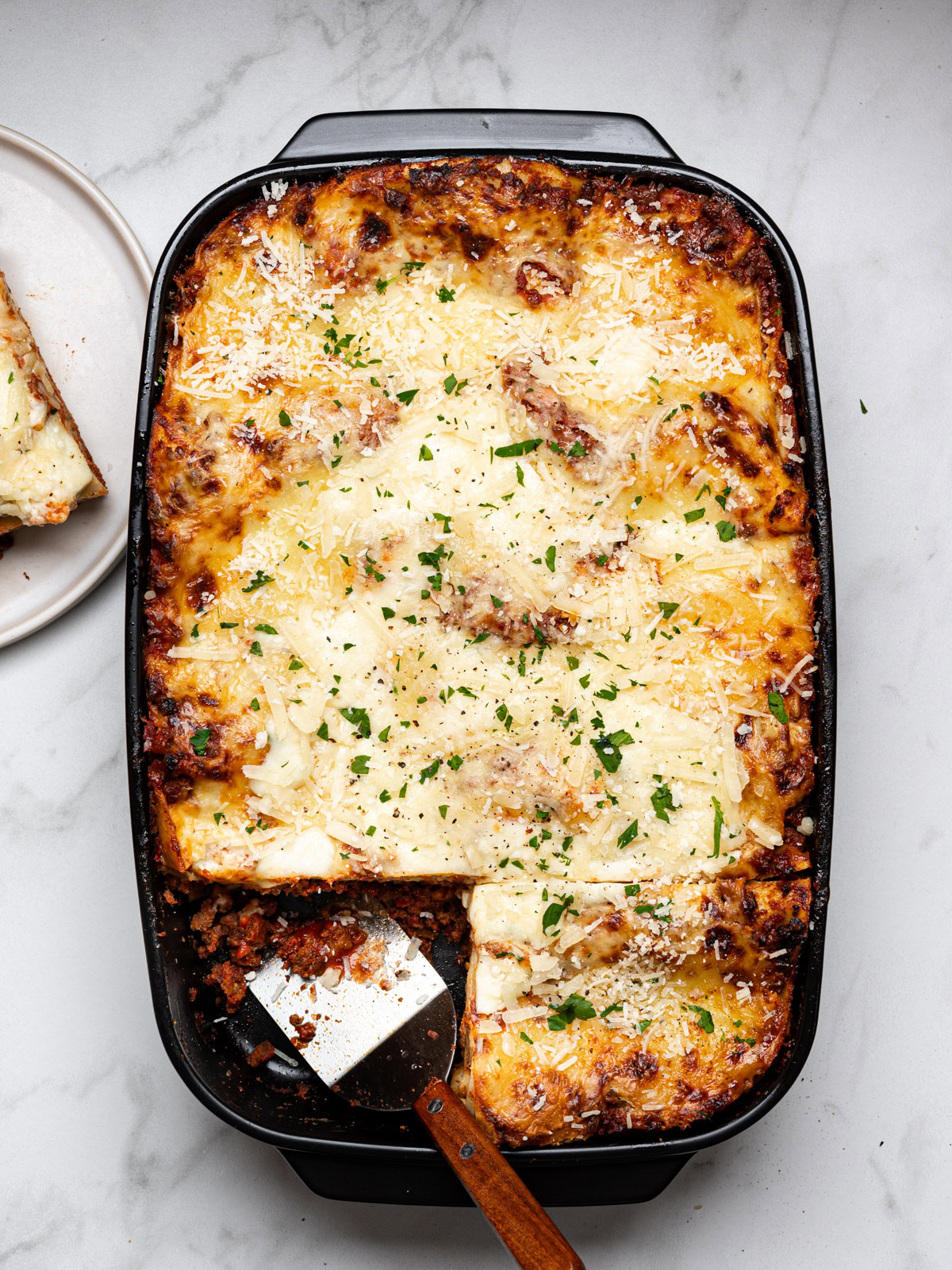
Serving Suggestions
Lasagna al forno is lovely accompanied by a nice green salad that is dressed simply with just olive oil and vinegar.
Some roasted broccolini or broccoli, would also make a great side to this lasagna.
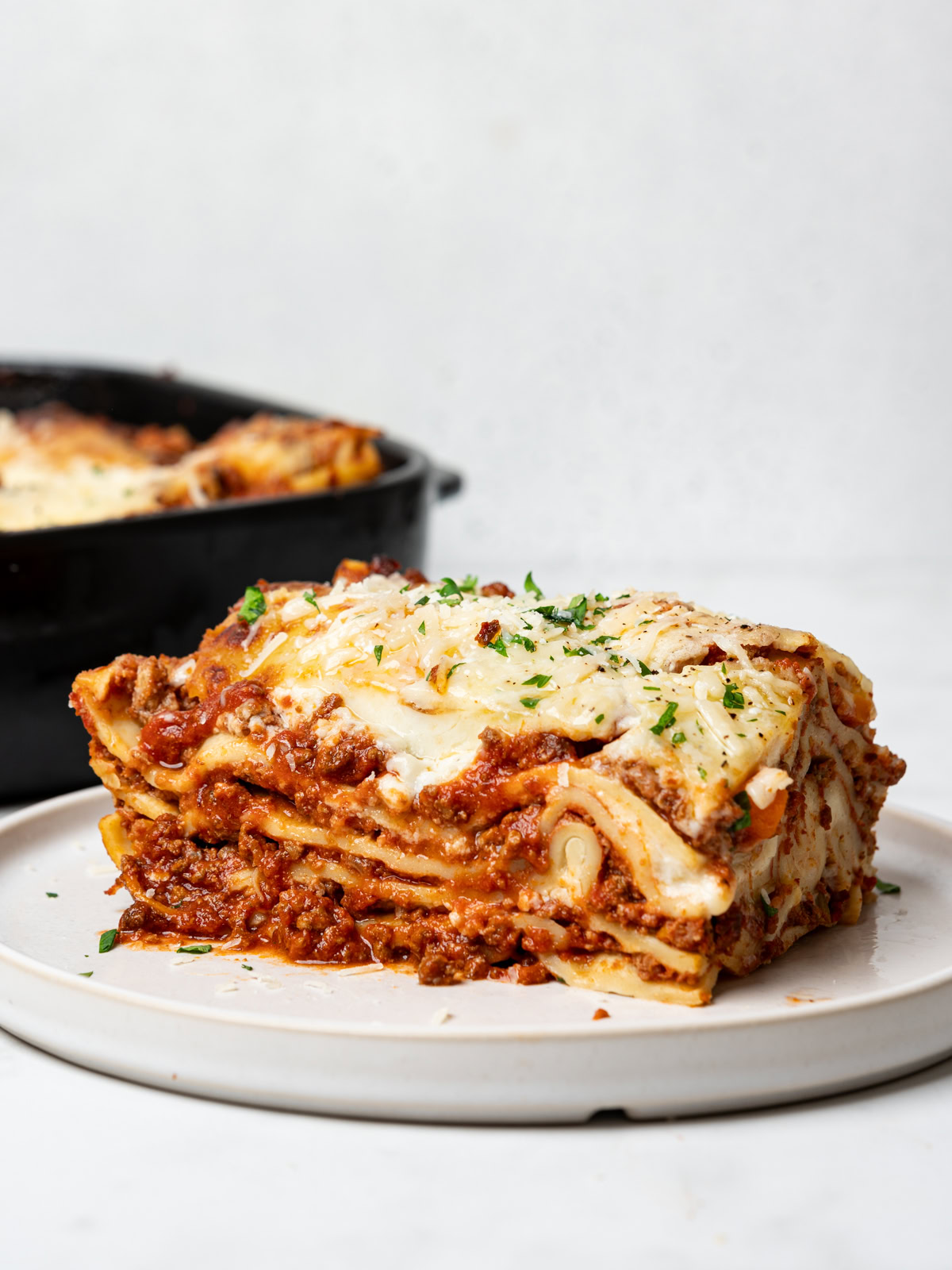
Make Ahead, Storing, And Reheating Tips
- To Store: Allow leftovers to cool completely. Place leftover lasagna in an airtight container in the fridge for 4-5 days. Alternatively, you can cover the whole lasagna pan tightly with 2 layers of aluminum foil and store in the fridge.
- To reheat: If reheating a whole casserole, cover the casserole with foil and bake in a a preheated oven at 350°F for 20-25 minutes, or until lasagna is heated through. Individual portions can be heated gently in a microwave or toaster oven.
- Make Ahead: Lasagna is a perfect dish for making ahead. You can assemble it up to 2 days ahead, then bake it just before serving. Or, assemble and bake it ahead, then reheat just before serving. Both methods work beautifully, but you’ll have to add a little more baking time to the lasagna that was refrigerated.
- Freezing: I prefer to freeze Lasagna before it’s been cooked. If planning on freezing, assemble lasagna in a freezer safe baking dish or foil pan. Cover tightly with 2-3 layers of aluminum foil and freeze for up to 3 months. You can bake from frozen if lasagna is in aluminum pans. If lasagna was assembled in ceramic baking dish, make sure to thaw overnight in the refrigerator. A frozen lasagna will need to bake at least 40 minutes longer than recipe instructs. Cold lasagna will need to bake about 15 minutes longer than instructed on the recipe.
Similar Recipes To Try
I hope you love this Lasagna al Forno recipe as much as we do! If you give this recipe a try, please let us know in the comment box below. Your review and rating is very helpful to me and other readers. Thank you!
Lasagna Al Forno

Ingredients
Bolognese
- 1 Tablespoon extra-virgin olive oil
- 3-4 ounces pancetta or bacon finely chopped
- 1 large onion finely diced
- 1 medium carrot peeled finely diced
- 2 celery stalks finely diced
- Kosher salt
- freshly cracked black pepper
- 2 pounds lean ground beef
- 1/4 cup tomato paste
- 1 cup whole milk
- 1 cup dry white wine
- 1 (750ml) jar of passata or 1 28-ounce can good-quality crushed tomatoes
- 2 bay leaves
- Pinch of finely grated nutmeg
- 3 cups low-sodium beef broth, divided
Béchamel
- 5 Tablespoons unsalted butter
- 5 Tablespoons all-purpose flour
- 4 cups (1 litre) whole milk
- 1 teaspoon kosher salt
- freshly cracked pepper, to taste
- 1/2 teaspoon nutmeg
- 3/4 cup freshly grated parmesan
Instructions
Bolognese
- Heat olive oil in a large pot over medium heat. Add pancetta and cook, stirring occasionally, until pancetta has released most of its fat, about 4-5 minutes. Stir in onion, celery and carrots, and cook, stirring occasionally, until vegetables are soft 6–8 minutes.
- Add the ground beef and cook, breaking it up with a wooden spoon, until brown. Stir in the tomato paste and cook for 1 minute. Pour in the milk and cook until the meat has absorbed most of the milk, about 4–5 minutes.
- Add the wine and let it simmer until slightly reduced, then add the passata, bay leaves, nutmeg and 2 cups of beef broth. Let simmer, over medium-low heat, uncovered, until the bolognese looks rich, thick, and tastes delicious, about 2 to 3 hours. If not using immediately, let cool and refrigerate, covered, for up to 2 days.
Béchamel
- In a medium saucepan, melt butter over medium heat. Sprinkle in the flour and whisk until a smooth paste forms. Continue whisking, and let paste cook about 1–2minutes.
- Whisking constantly so no lumps form, slowly drizzle in half of the milk. Once incorporated, add the rest of the milk, still whisking. Bring to a gentle boil, stirring constantly, then lower to a simmer. Add salt, pepper and nutmeg and continue to cook, stirring frequently, until sauce thickens and coats the back of a wooden spoon, about 4–6 minutes. Remove from heat and stir in the parmesan.
- If not using immediately, place a piece of plastic wrap directly over top of sauce to prevent a hard film from forming.
Assemble and Bake Lasagna
- Preheat oven to 400ºF.
- Lightly butter a 9×13 baking dish. Spread a little bolognese sauce over the base. Note: If your bolognese sauce seems very thick, add remaining 1 cup of broth, or water, to loosen it.
- Next, add a single layer of pasta sheets on top of the sauce. It's okay if you need to cut some of the sheets to make them fit.
- Then, cover pasta with a thin layer of béchmal followed by another layer of ragu. Repeat the process, finishing with a layer of pasta topped with béchamel sauce. You should have 4 to 5 layers. If using fresh mozzarella slices, scatter them evenly over top of your lasagna and sprinkle with parmesan cheese.
- Cover entire dish with foil and bake for 25 minutes. Remove foil and bake another 20–25 minutes or until lasagna is bubbly, golden brown, and crispy-edged.
- Let cool for 10–15 minutes before slicing.
Notes
- Bolognese – This lasagna al forno relies on a rich and deeply flavored bolognese sauce. This can only be achieved with a long cooking time. Don’t rush the cooking time or the lasagna will not be as good. In addition, the bolognese should not be covered or the liquids will not reduce enough.
- Lasagna sheets – The amount of lasagna sheets needed will depend on which lasagna sheets you use. Mine were quite large so I only needed 8-10. If using dried pasta sheets, boil or no-boil, you will need more like 16. If using no-boil lasagna sheets, make they are throughly covered in sauce so they cook properly. If using lasagna sheets that require boiling, follow package instructions but do not over cook them.
- Make Ahead: Lasagna is a perfect dish for making ahead. You can assemble it up to 2 days ahead, then bake it just before serving. Or, assemble and bake it ahead, then reheat just before serving. Both methods work beautifully, but you’ll have to add a little more baking time to the lasagna that was refrigerated.


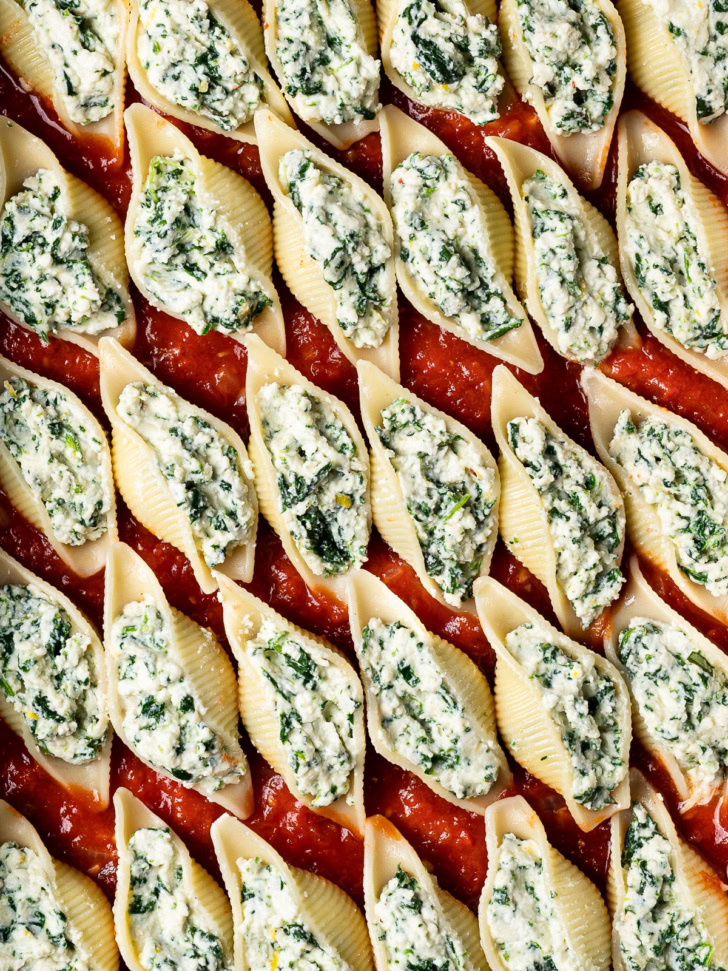
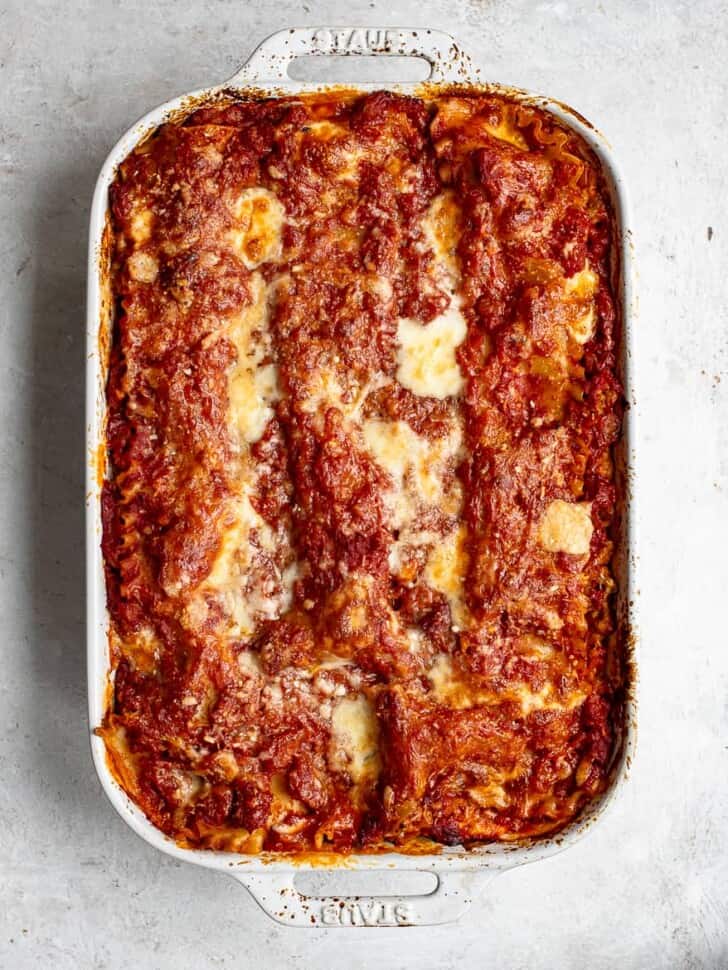
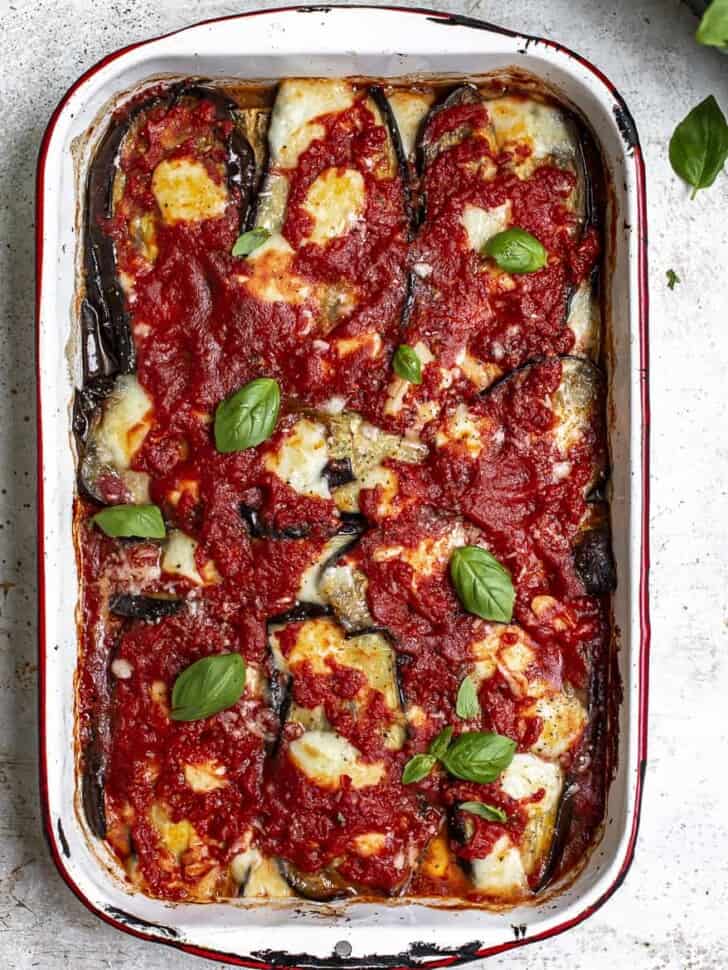
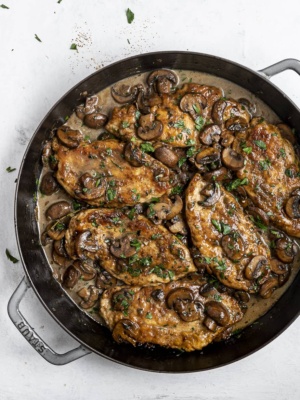
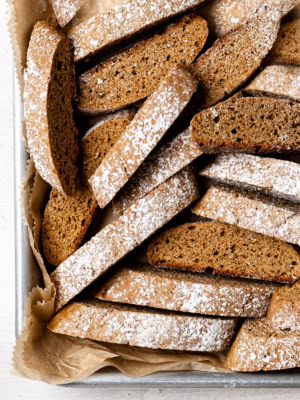

Mayte
Finally a recipe is not distort by Americans! Authentic lasanha with beef and not that like “cat poop) Italian sausage and bechamel
Instead ricotta
Almost the same recipe my Italian nona used to use. Delicious. Didn’t add or subtract anything. It is the best
Even the pancetta Nona didn’t use, I did and it elevate the taste to another level
Sandra Valvassori
I am so happy to hear this lasagna reminds you of your Nona’s, Mayte! Thank you so much for taking the time to write such a kind review, really appreciate it.